Analysis of the First Metallic Works That Represented a Geometric Innovation in Their Architectural Application: The Origin of the Architecture-Engineering Dichotomy
Abstract
1. Introduction
2. Methods
3. Development of the Research and Achievement of Objectives
3.1. Description of the First Expressions of the Influences of the Technique in Architecture
3.2. Study of the Origins of the Relationship between Architecture and Engineering in France
3.3. Analysis According to Periodical Publications in France and Britain
“My favorite occupation in recent years in my residence in Europe has been the study of suspension bridges… Let just one such bridge stand in Philadelphia exhibiting the beautiful forms that come from the maximum utilization of the structural system, and it will not need a prophecy to predict the effect this bridge will have on the intelligent minds of Americans.”
4. Discussion
5. Conclusions and Results
Author Contributions
Funding
Data Availability Statement
Acknowledgments
Conflicts of Interest
Appendix A
- A1.
- Pierre-François-Léonard Fontaine (1762–1853). French architect who had a very classical line in his built work, but who worked on major restoration projects in France, such as the project for the restoration of Chambord Castle. He moved away from his natural line, although he influenced an eminently classical composition, in the project referred to in the text.
- A2.
- Charles Rohault de Fleury (1801–1875). French architect greatly influenced by Rome and Italian architecture. His writings include Manuel des lois du bâtiment of 1862 and Monuments de Pise au Moyen Âge of 1866. However, his built work was more innovative than his theoretical contribution in the combination of tradition and technology. His was a very early example of French iron and glass architecture, The Mexican Hothouse, built in 1834–1836, and later, along the same lines, together with the architect Alfred Armand (1805–1888), the Grand Hôtel du Louvre built in 1855.
- A3.
- Abraham Darby (1678–1717) He played a key role during the industrial revolution, developing the method of producing iron in a blast furnace using coke instead of coal. With this production, iron acquired a high quality and became the basic material for industry.
- A4.
- Victor Louis (1731–1800). French architect who designed and executed many of the great theatres of the time, such as the Grand Theatre in Bordeaux in 1780 and the National Theatre on rue de la Loi in 1793. His experience with large roofs and great lights gave this architect great confidence when it came to using new materials.
- A5.
- César Denis Daly (1811–1894). French architect, pupil and disciple of Félix Duban (1798–1870). He was the forerunner of Viollet Le Duc as a restoration architect. He was, above all, a tremendously influential architect in terms of dissemination and position. He founded the “Société d’artistes décorateurs et industriels” in 1848, was the secretary of the “Société centrale des architectes”, owner, founder, and editor of the publications “Revue Générale de l’architecture et des travaux publics” between 1840 and 1888 and “La Semaine des constructeurs” between 1877 and 1895.
- A6.
- François-Joseph Bélanger (1744–1818). A French architect who studied at the Royal Academy of Architecture in Paris, he was close to the court and became the personal architect of the brother of King Louis XVI. He was one of the few architects of the time who was not directly influenced by Italy, as he did not make the study trip to that country, which gave him a somewhat different vision of the use of technology in architecture, which is clearly seen in his reconstruction work referred to in the text.
- A7.
- Jules Saulnier (1817–1881). French architect. He was not a particularly prolific architect, but the Menier Chocolate Factory project was highlighted in 1997 as “one of the iconic buildings of the industrial revolution” in the specialist publication Architectural Review.
- A8.
- Established in 1747 by Daniel-Charles Trudaine (1703–1769) under the name “École royale des ponts et chaussées”. In 1775 the name was changed to “École nationale des ponts et chaussées”; it can be seen under the latter name in other texts.
- A9.
- Called “École royale du génie de Mézières” it was founded in 1748 by Count D’Argenson and Nicolas de Chastillon. The first training of engineers included a strong education in mathematics and chemistry, in fact this school was the place of study of great scientists (not engineers per se) such as Pierre-Simon Laplace, Charles Étienne Louis Camus, Étienne Bézout, Sylvestre François Lacroix, Siméon or Denis Poisson, Gaspard Monge.
- A10.
- Eugène-Emmanuel Viollet-le-Duc (1814–1879) French architect, restorer and architectural theorist. His main field of experimentation was the historic monument. He began to develop his restoration methodology from his first intervention, in the Basilica of Sainte-Marie-Madeleine de Vézelay, and was an important architect of the Gothic Revival.
- A11.
- Jean-Rodolphe Perronet (1708–1794). A French architect specialising in the design and construction of bridges, he was an outstanding structuralist of the time. In fact, he drew up tables for calculating bridge arches that were used by architects and engineers for almost the entire century.
- A12.
- It was Pope Benedict XIV who, faced with the obvious damage to the dome, decided to call on three prestigious mathematicians, Francesco Jacquier, Tommaso Le Seur and Ruggiero Giuseppe Boscovich, who in 1743 wrote a report on the problem of stability. The title of the report is: Parere di tre mattematici sopra i danni, che ji fono trovati nella cupo la di S. Pietro, sul fine del!’ Anno MDCCXLII. The engineer referred to in the text is Giovanni Poleni (1683–1761) who, although he did not sign the report, was the one who prescribed the execution of the strapping of the dome and who, in 1748, documented the work on the dome and its restoration in the text: Memorie Istoriche della Gran Cupola del Tempio Vaticano, e de danni di essa, e de ristoramenti loro.
- A13.
- Thomas Telford (1757–1834). Builder and designer of roads, canals and bridges. Telford actually wrote his autobiography in 1838, The Life of Thomas Telford, Civil Engineer, written by himself, in which he describes himself as an architect, although neither his education nor his works were, strictly speaking, architecture. He initially spent two years training with the architects Robert Adam and William Chambers, but soon found work in the port learning about the design, specification and execution of civil works until 1787, when he was appointed as a supervisor of public works and began his career as an engineer.
- A14.
- Robert Stephenson (1803–1859). English civil engineer. Son of George Stephenson (1781–1848), the two of them founded one of the largest and first locomotive construction companies, the Robert Stephenson Company, which, among other achievements, designed and built “The Rocket” locomotive. Thanks to his knowledge of railways and locomotives and his engineering studies, Robert Stephenson was a consultant and designer of major international bridges.
- A15.
- John Augustus Roebling (1806–1869). American civil engineer, pioneer in the design and construction of suspension bridges based on French-based calculations. He was also the designer and manufacturer of the steel cable for suspension structures.
- A16.
- Charles Ellet, Jr. (1810–1862). American civil engineer. Reference is made in the text to the Philadelphia Suspension Bridge when John Augustus Roebling was working in the United States after the Napoleonic Wars. The full quotation in the book by Steinman, David B. and Watson, Sara Ruth called Bridges and their Builders (1941).
- A17.
- Alexandre Gustave Eiffel (1832–1923) French civil engineer. He gained fame with the design of several railway bridges in France, of which the Garabit Viaduct is particularly notable.
- A18.
- Victor Contamin (1840–1893). French structural engineer. Disciple of Jean-Baptiste-Charles-Joseph Bélanger. Contamin was also a pioneer in the use of reinforced concrete, working in this field with the architect Anatole de Baudot (1834–1915). Also, in 1889, Contamin worked with the architect Ferdinand Dutert (1845–1906) on the design of the Galerie des Machines at the Universal Exhibition, where he was also able to see Eiffel’s work directly.
- A19.
- Isambard Kingdom Brunel (1806–1859). English engineer. Pioneer in suspension bridge structures. He was also a designer of steamships and an advisor on the construction of railway lines.
- A20.
- Proceedings of the First International Congress on Construction Procedures. Published in Paris in 1889 on the occasion of the Universal Exhibition. The text quoted in the text is written by Eiffel in his “Notes on metal constructions” as part of these proceedings.
- A21.
- As an example of this, I list several articles published in the Revue Générale de l’architecture et des travaux publics in its first issue of 1840 that develop the idea cited in the text: Application des machines locomotives à la navigation sur les canaux. Pages 119–120 of the February issue (Mélanges section); Nouvelle machine à épuisement. Pages 120–121 of the February issue (Mélanges section); Machines employed in Angleterre pour embarquer le charbon signed by M.E. Teisserenc. Pages 149–157 of the March issue (Mélanges section); Importations de Machines Anglais. Pages 631–632 of the October issue (Mélanges section); Machines à vapeur. Pages 701–702 of the November issue (Mélanges section).
- A22.
- As an example of this, I list several articles published in the Revue Générale de l’architecture et des travaux publics in its first issue of 1840 which develop the idea cited in the text: Tableau d’État de répartition, entre les départements, du Fonds communs destiné par la loi du 10 mai 1838 (article 17), et la loi des dépenses de 1840 signed by Louis Philippe. Pages 126–128 of the February issue (Mélanges section); Tableau du mouvements des principaux chemins de fer anglais signed by César Daly. Page 583 of the September issue (Mélanges section); Tableau du mouvements des principaux chemins de fer anglais signed by César Daly. Page 647 of the October issue (Mélanges section); Tableau du mouvements des principaux chemins de fer anglais signed by César Daly. Page 711 of the November issue (Mélanges section).
- A23.
- As an example of this, I list several articles published in the Revue Générale de l’architecture et des travaux publics in its first issue of 1840 that develop the idea cited in the text: Théorie des Ponts suspendus signed by M. J. Huguenet. Panel 4 of the February issue (section “Plates”). Théorie des Ponts suspendus signed by M. J. Huguenet. Plate 5 of the February issue (under “Plates”).
- A24.
- As an example of this, I list several articles published in the magazine The Builder in its first issue of 1843 which develop the idea cited in the text: Most important invention. The paten stucco, paint, cement, page 14; Palmer’s Patent Glyphography or engraved drawings, page 34; Patent Stone-cutting machine and patent iron masons!, pages 41–42; Patent iron masons, page 54; List of patents, page 117; Scotch patents, page 118.
- A25.
- As an example of this, I list several articles published in the Revue Générale de l’architecture et des travaux publics in its first issue of 1840 which develop the idea cited in the text: Expression de la tension des chaines. Pages 90–91 of the February issue (Mélanges section); Lieut. Forme, on trigonometrical surveying signed by M. V. Coste. Pages 476–480 of the August issue (Mélanges section).
- A26.
- As an example of this, I list several articles published in the Revue Générale de l’architecture et des travaux publics in its first issue of 1840 that develop the idea cited in the text: De l’Architecture Byzantine signed by M. Albert Lenoir. Pages 7–17 of the January issue (History section); Musée historique d’Architecture signed by M. Tournal. Pages 17–20 of the January issue (History section). In fact, there is an exclusive History section in the magazine.
- A27.
- As an example of this, I list several articles published in the Revue Générale de l’architecture et des travaux publics in its first issue of 1840 which develop the idea cited in the text: Architecture Chrétienne de l’Occident, style latin (première-derniére partie) signed by M. Albert Lenoir. Pages 257–267 of the May issue, Pages 321–327 of the June issue, Pages 449–436 of the August issue and Pages 585–590 of the October issue.
- A28.
- This engraving will be part of the Review from its first volume and will appear intermittently throughout its publication.
- A29.
- Des Artistes au Moyen-Age et des Monuments élevés à leur mémoire (deuxième et dernière partie), written by M. F. de Guilhermy, pages 193–197.
- A30.
- Jean-Baptiste Rondelet (1743–1829). French architect. Disciple of the architect previously mentioned in this text Jacques-François Blondel. The treatise referred to in the text is the one published between 1802 and 1817 with a total of ten books divided into five volumes called Traité theorique et pratique de l’Art de Bâtir (Theoretical and practical treatise on the art of building).
- A31.
- As an example of this, I list several articles published in the Revue Générale de l’architecture et des travaux publics in its first issue of 1840 that develop the idea cited in the text: Théorie des ponts extensibles. Art. 2 Tracé de la courbe par le calcul. Pages 76–81 of the February issue (Theory section).
- A32.
- As an example of this, I list several articles published in the Revue Générale de l’architecture et des travaux publics in its first issue of 1840 which develop the idea cited in the text: Machines employées en Angleterre pour embarquer le charbon (première partie) signed by M.E. Teisserenc. Pages 149–157 of the March issue (Practical section); Détails de construction d’un embarcadère pour le charbon signed by M. J. Huguenet. Plate 7 of the March issue (Practical section); Mines de charbon dans l’Inde on page 376 of the June issue (under “Mélanges”).
- A33.
- As an example of this, I list several articles published in the Revue Générale de l’architecture et des travaux publics in its first issue of 1840 that develop the idea cited in the text: Poêles et calorifères à Anthracite, en usage aux Etats-Units. Etendue et production des gìtes d’Anthracite de la Pensylvanie signed by M. Michel Chevalier. Pages 399–406 of the July issue (Practical section); Poêles et Calorifères à Anthracite en usage aux Etats-Unis (suite et fin) signed by M. Michel Chevalier. Pages 456–466 of the August issue (Practice section).
- A34.
- As an example of this, I list several articles published in the Revue Générale de l’architecture et des travaux publics in its first issue of 1840 which develop the idea cited in the text: Notice sur un nouveau système de charpente en bois et en fer signed by M. Camille Polonceau. Pages 27–33 of the January issue (Practice section); Nouveau système de bateaux à vapeur. July issue (under “Mélanges”); Liste des principaux Brevets d’Invention délivrés pendant le deuxième trimestre de 1840. October issue (under “Mélanges”).
References
- Lemoine, B. Les revues d’architecture et de construction en France au XIXe siècle. Rev. De L’art 1990, 89, 65–71. [Google Scholar] [CrossRef]
- Sutherland, R.J.M. Structural Iron 1750–1850; Routledge: London, UK, 1998. [Google Scholar]
- Bertrand, L. L’Architecture Du Fer: France, Xixe Siecle; Champ Vallon: Ceyzérieu, France, 1986. [Google Scholar]
- Percier, C.; Fontaine, P.F.L. Recueil de décorations intérieures comprenant tout ce qui a rapport à l’ameublement, comme vases, trépieds, candélabres, cassolettes, lustres, girandoles, lampes, chandeliers, cheminées, feux, poêles, pendules, tables, secrétaires, lits, canapés, fauteuils, chaises, tabourets, miroirs, exécutés sur leurs dessins. Paris, France. 2013. Available online: https://gallica.bnf.fr/ark:/12148/bpt6k857253 (accessed on 18 January 2022).
- Fox, J.P.; Di Castro, D. Disegni dall’antico di Pierre-François-Léonard Fontaine (1762–1855) architetto di Napoleone; Edizioni Polistampa: Firenze, Italy, 2007. [Google Scholar]
- Mead, C.C. Charles Garnier’s Paris Opera and the Renaissance of Classicism in Nineteenth-Century French Architecture (Beaux-Arts); University of Pennsylvania: Pennsylvania, PA, USA, 1986. [Google Scholar]
- Trinder, B.S. The Darbys of Coalbrookdale; Phillimore: Michigan, MI, USA, 1974. [Google Scholar]
- Zhou, H.; Wu, S.; Kou, M.; Yao, S.; Shen, Y. Analysis of Coke Oven Gas Injection from Dome in COREX Melter Gasifier for Adjusting Dome Temperature. Metals 2018, 8, 921. [Google Scholar] [CrossRef]
- Dobraszczyk, S.P. Function and Fantasy: Iron Architecture in the Long Nineteenth Century; Routledge: London, UK, 2018. [Google Scholar]
- Sigfried Giedion, J.D.B. Building in France, Building in Iron, Building in Ferroconcrete; Oxford University Press: Oxford, UK, 1996. [Google Scholar]
- Ji, T.; Bell, A. Seeing and Touching Structural Concepts.; Taylor & Francis: London, UK, 2008. [Google Scholar]
- Marionneau, C. Victor Louis, Architecte du Théâtre de Bordeaux: Sa vie, ses Travaux et sa Correspondance, 1731–1800; G. Gounouihou: Bordeaux, France, 1881; Available online: https://ccfr.bnf.fr/portailccfr/ark:/06871/0011936093 (accessed on 20 January 2022).
- Chalvatzi, K. Theatre Construction in Eighteenth-Century France: The Opera of the Palais-Royal in Paris and its Impact on Theatre Construction. Studies in the History of Services and Construction. In Proceedings of the Fifth Conference of the Construction History Society, Cambridge, UK, 6–8 April 2018; pp. 315–326. [Google Scholar]
- Christensen, P.H. Precious Metal: German Steel, Modernity, and Ecology; Penn State University Press: Pennsylvania, PA, USA, 2022. [Google Scholar]
- Main Header Engraving in the First Issue of the Magazine. Revue Générale de L’architecture et des Travaux Publics, France, 1840: Volume 1, col.1. p. Available online: https://portaildocumentaire.citedelarchitecture.fr/pdfjs/web/viewer.html?file=/Infodoc/ged/viewPortalPublished.ashx?eid%3DIFD_FICJOINT_FRAPN02_RA_1840_01_PDF_1 (accessed on 20 January 2022).
- Chevalier, M.M. Bridge over the James River. Longitudinal Elevation and Section Located in Richmond, Virginia. (Engraving). Source: "Revue Générale de l’architecture et des Travaux Publics", France, 1840: Volume 1, (Pl.3). Available online: https://portaildocumentaire.citedelarchitecture.fr/pdfjs/web/viewer.html?file=/Infodoc/ged/viewPortalPublished.ashx?eid%3DIFD_FICJOINT_FRAPN02_RA_1840_1801_PDF_1841 (accessed on 15 March 2022).
- Flury, A. Coperation the Engineer and the Architect; Birkhauser verlag AG: Basel, Switzarland, 2011. [Google Scholar]
- De Harlez De Deulin, N. François-Joseph Bélanger, architecte et “jardineur” auprès du prince de Ligne à Beloeil. In Proceedings of the Colloque international François-Joseph Bélanger (1744–1818) Architecture et société de l’ancien régime à la Restauration, Paris, France, 27 December 2021. [Google Scholar]
- Perry, R. François-Joseph Belanger’s Bath-House at the Hôtel de Brancas. Archit. Hist. 2001, 44, 377–385. [Google Scholar] [CrossRef]
- Li, C.; Wang, L.; Weng, Y.; Qin, P.; Li, G. Nonlinear Analysis of Steel Structure Bent Frame Column Bearing Transverse Concentrated Force at the Top in Factory Buildings. Metals 2020, 10, 1664. [Google Scholar] [CrossRef]
- Drouard, A. ‘The biggest chocolate factory in the world’: The Menier Chocolate Factory in Noisiel. Food Ind. Eur. Ninet. Twent. Centuries 2013, 91. [Google Scholar] [CrossRef]
- Peters, T.F. The relative value of invention and the history of tall buildings. In Second Century of the Skyscraper; Springer: Berlín, Germany, 1988; pp. 25–32. [Google Scholar]
- Sandaker, B.N. On Span and Space. Exploring Structuras en Architecture; Routledge: London, UK, 2008. [Google Scholar]
- Altadill, J.Á. Las propuestas no construidas de Violet-le-Duc: Reinterpretación objetiva y análisis de la estabilidad de la nave abovedada. In Actas del Noveno Congreso Nacional y Primer Congreso Internacional Hispanoamericano de Historia de la Construcción: Segovia, 13 a 17 de octubre de 2015; Instituto Juan de Herrera: Madrid, Spain, 2015; pp. 85–93. [Google Scholar]
- Rueda Márquez de la Plata, A. La corrección geométrica aplicada a la estabilidad estructural en los métodos de reconstrucción. Vezelay. Hitos Estructurales de La Arquitectura y La Ingeniería. In Jornadas Internacionales de Investigación en Construcción; Instituto CC Eduardo Torroja, CSIC: Madrid, Spain, 2011. [Google Scholar]
- Rueda Marquez de la Plata, A.; Cruz Franco, P.A. A Simulation Study to Calculate a Structure Conceived by Eugene Viollet-le-Duc in 1850 with Finite Element Analysis. Materials 2019, 12, 2576. [Google Scholar] [CrossRef] [PubMed]
- Perronet, J.-R. La Construcción de Puentes en el Siglo XVIII; Reverte: Barcelona, Spain, 2005. [Google Scholar]
- Perronet, J.R. Description des Projets et de la Construction des Ponts de Neuilli, de Mantes, d’Orléans, de Louis XVI, etc; Didot: Madrid, Spain, 1788. [Google Scholar]
- Smith Ketchum, M. Structural Engineers’ Handbook: Data for the Design and Construction of Steel Bridges and Buildings; Forgotten Books: London, UK, 2018. [Google Scholar]
- Murphy, K.D.; Viollet-le-Duc, E.E. Memory and Modernity: Viollet-le-Duc at Vézelay; Penn State Press: Pennsylvania, PA, USA, 1999. [Google Scholar]
- Chrimes, M. The business of the early consulting engineer: The case of Thomas Telford (1815–1834). In History of Construction Cultures; CRC Press: Florida, FL, USA, 2021; pp. 463–470. [Google Scholar]
- Smith, T. Pontcysyllte aqueduct-A world heritage site. Steel Times Int. 2018, 42, 48. [Google Scholar]
- Hodson, H. The railway contractors. Steel Times Int. 2015, 39, 40. [Google Scholar]
- Preene, M. Robert Stephenson (1803–1859)-the first groundwater engineer. Spec. Publ.-Geol. Soc. Lond. 2004, 225, 107–120. [Google Scholar] [CrossRef]
- Boudsot, M.A.-A. Graphical Extract from the Article Suspension Bridge Theory. Source: “Revue Générale de L’architecture et des Travaux Publics”, France, 1840: Volume 1, (Pl.1), p. Available online: https://portaildocumentaire.citedelarchitecture.fr/pdfjs/web/viewer.html?file=/Infodoc/ged/viewPortalPublished.ashx?eid%3DIFD_FICJOINT_FRAPN02_RA_1840_1801_PDF_1841 (accessed on 20 March 2022).
- Boudsot, M.A.-A. Graphical Extract from the Article Suspension Bridge Theory. Source: “Revue Générale de L’architecture et des Travaux Publics”, France, 1840: Volume 1, (Pl.4), p. Available online: https://portaildocumentaire.citedelarchitecture.fr/pdfjs/web/viewer.html?file=/Infodoc/ged/viewPortalPublished.ashx?eid%3DIFD_FICJOINT_FRAPN02_RA_1840_1802_PDF_1841 (accessed on 23 March 2022).
- Kahlow, A. Johann August Röbling (1806–1869)—Early Projects in Context. In John A. Roebling: A Bicentennial Celebration of His Birth 1806-2006; American Society of Civil Engineers: New York, NY, USA, 2007; pp. 1–26. [Google Scholar]
- MacKaron, E.; John, A. Roebling Suspension Bridge; University of Cincinnati: Ohio, OH, USA, 2009. [Google Scholar] [CrossRef]
- Stover, J.F.; Ellet, C., Jr. 1810–1862, the Engineer as Individualist; JSTOR: New York, NY, USA, 1969. [Google Scholar]
- Ono, K. Size Effects of High Strength Steel Wires. Metals 2019, 9, 240. [Google Scholar] [CrossRef]
- The Bridge-Tunnel or Air Tunnel over the Menai Strait. Detail of the Screwed and Gusseted Drawer Structure. Source: "Revue Générale de L’architecture et des Travaux Publics", France, 1849: Volume 8, (Pl.22). p. Available online: https://portaildocumentaire.citedelarchitecture.fr/pdfjs/web/viewer.html?file=/Infodoc/ged/viewPortalPublished.ashx?eid%3DIFD_FICJOINT_FRAPN02_RA_1849_04_PDF_1 (accessed on 23 March 2022).
- Laska, W. Masonry and Steel: Detailing Handbook; Aberdeen Group: Washington, WA, USA, 1993. [Google Scholar]
- Durant, S. Gustave Eiffel: Aerodynamic experiments 1903–1921. Proc. Inst. Civ. Eng.-Eng. Hist. Herit. 2013, 166, 227–235. [Google Scholar] [CrossRef]
- Linares de la Torre, Ó. Apuntes sobre el Palais des Machines de París de 1889: Espacio, estructura y ornamento. VLC Arquit. 2018, 5, 33–61. [Google Scholar] [CrossRef]
- Isambard Brunel, B.C.L. The life of Isambard Kingdom Brunel; Longmans, Green Co.: London, UK, 1870; Available online: https://archive.org/details/lifeofisambardki00brunuoft/page/ii/mode/2up?ref=ol&view=theater (accessed on 2 April 2022).
- Extract from the Article “Historic Monuments”. Source: “Revue Générale de L’architecture et des Travaux Publics”, France, 1840: Vol.4, col.241. p. Available online: https://portaildocumentaire.citedelarchitecture.fr/pdfjs/web/viewer.html?file=/Infodoc/ged/viewPortalPublished.ashx?eid%3DIFD_FICJOINT_FRAPN02_RA_1840_04_PDF_1 (accessed on 23 March 2022).
- Denfert Rochereau, M. Graphic and Geometric Calculation of Barrel Vaults. Part of the Article Written by M. Denfert Rochereau in the Magazine. Source: “Revue Générale de l’architecture et des Travaux Publics”, France, 1859: Vol.7 (Pl.54), p. Available online: https://portaildocumentaire.citedelarchitecture.fr/pdfjs/web/viewer.html?file=/Infodoc/ged/viewPortalPublished.ashx?eid%3DIFD_FICJOINT_FRAPN02_RA_1859_1803_PDF_1851 (accessed on 23 March 2022).
- Barré, L. Table-Strength Record of Double T profiles. Source: “Revue Générale de l’architecture et des Travaux Publics”, France, 1858: Vol.2, (Pl.12-22), p. Available online: https://portaildocumentaire.citedelarchitecture.fr/pdfjs/web/viewer.html?file=/Infodoc/ged/viewPortalPublished.ashx?eid%3DIFD_FICJOINT_FRAPN02_RA_1858_1802_PDF_1851 (accessed on 23 March 2022).
- Bleuze. Patent for Light Metallic Structures. Source: “Revue Générale de L’architecture et des Travaux Publics”, France, 1858: Vol.6, (Pl.34)., p. Available online: https://portaildocumentaire.citedelarchitecture.fr/pdfjs/web/viewer.html?file=/Infodoc/ged/viewPortalPublished.ashx?eid%3DIFD_FICJOINT_FRAPN02_RA_1858_1805_PDF_1851 (accessed on 23 March 2022).
- Sirodot. Different Types of Patents for Lightweight Metal Slabs. Source: “Revue Générale de L’architecture et des Travaux Publics”, France, 1853: Vol.11, (Pl.9,10,12), p. Available online: https://portaildocumentaire.citedelarchitecture.fr/pdfjs/web/viewer.html?file=/Infodoc/ged/viewPortalPublished.ashx?eid%3DIFD_FICJOINT_FRAPN02_RA_1853_1802_PDF_1851 (accessed on 23 March 2022).
- Chen, Z.; Ge, H.; Chan, S. Modelling, Test and Practice of Steel Structures. Metals 2022, 12, 1212. [Google Scholar] [CrossRef]
- Viollet-le-Duc, E.-E. Entretiens sur l’architecture; Q. Morel et cie: Paris, France, 1863. [Google Scholar]
- Guilhermy, Engraving from the article called “Artists of the Middle Ages. And the Monuments Studied in his Memory”. Source: “Revue Générale de l’architecture et des Travaux Publics”, France, 1840: Vol.1, col.140. p. Available online: https://portaildocumentaire.citedelarchitecture.fr/pdfjs/web/viewer.html?file=/Infodoc/ged/viewPortalPublished.ashx?eid%3DIFD_FICJOINT_FRAPN02_RA_1840_03_PDF_1 (accessed on 23 March 2022).
- de Guilhermy, F. L’abbaye de Saint-Denis: Tombeaux et Figures Historiques des Rois de France; Vve Vagneur: París, France, 1882; Available online: https://gallica.bnf.fr/ark:/12148/bpt6k379140f/f8.item (accessed on 2 April 2022).
- Heyman, J. Analisis de Estructuras. Un Estudi Historico; Instituto Juan de Herrera: Madrid, Spain, 2004. [Google Scholar]
- Booth, D. Some Little-Known Designs by Louis-Pierre Baltard and Jean-Baptiste Rondelet for the Transformation of the Church of the Madeleine into a Temple of Glory. RACAR Rev. D’art Can./Can. Art Rev. 1989, 16, 147–154. [Google Scholar]
- Ponsot, P. Robin Middleton et Marie-Nöelle Baudouin-Matuszek, Jean Rondelet: The Architect as Technician, 2007. Bull. Monum. 2013, 171, 182–184. [Google Scholar]
- Aghayere, A.O.; Jason, V. Structural Steel Design; Mercury Learning and Information: Virginia, VA, USA, 2020. [Google Scholar]
- Louis-Philippe. Example of One of the Data Tables on the Movements of Light Metal Slabs Accompanying the Article “Metallic slabs” Source: “Revue Générale de L’architecture et des Travaux Publics”, France, 1840: Vol.10, col.647, p. Available online: https://portaildocumentaire.citedelarchitecture.fr/pdfjs/web/viewer.html?file=/Infodoc/ged/viewPortalPublished.ashx?eid%3DIFD_FICJOINT_FRAPN02_RA_1840_1810_PDF_1841 (accessed on 23 March 2022).
- Teisserenc. Detail of Machinery Used to Ship Coal in England (2). Source: “Revue Générale de l’architecture et des Travaux Publics”, France, 1840: Vol. 1, (Pl.8). P. Available online: https://portaildocumentaire.citedelarchitecture.fr/pdfjs/web/viewer.html?file=/Infodoc/ged/viewPortalPublished.ashx?eid%3DIFD_FICJOINT_FRAPN02_RA_1840_1803_PDF_1841 (accessed on 23 March 2022).
- Teisserenc. Detail of Machinery Used to Ship Coal in England. Source: “Revue Générale de l’architecture et des Travaux Publics”, France, 1840: Vol. 1, (Pl.7). P. Available online: https://portaildocumentaire.citedelarchitecture.fr/pdfjs/web/viewer.html?file=/Infodoc/ged/viewPortalPublished.ashx?eid%3DIFD_FICJOINT_FRAPN02_RA_1840_1803_PDF_1841 (accessed on 23 March 2022).
- Steam Fireplace Detail. Source: “Revue Générale de L’architecture et des Travaux Publics”, France, 1840: Vol. 4, (Pl.9), p. Available online: https://portaildocumentaire.citedelarchitecture.fr/pdfjs/web/viewer.html?file=/Infodoc/ged/viewPortalPublished.ashx?eid%3DIFD_FICJOINT_FRAPN02_RA_1840_1804_PDF_1841 (accessed on 23 March 2022).
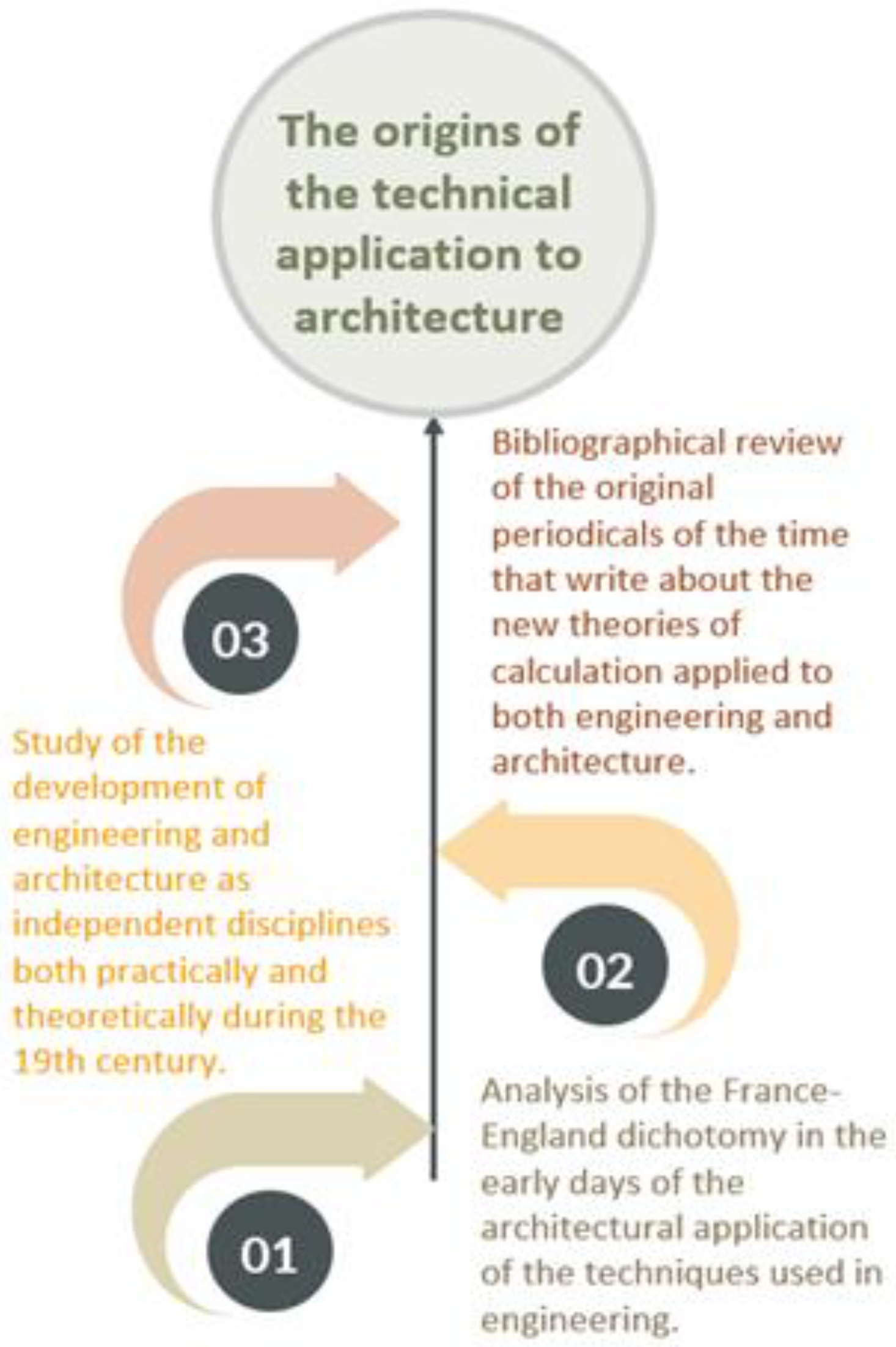
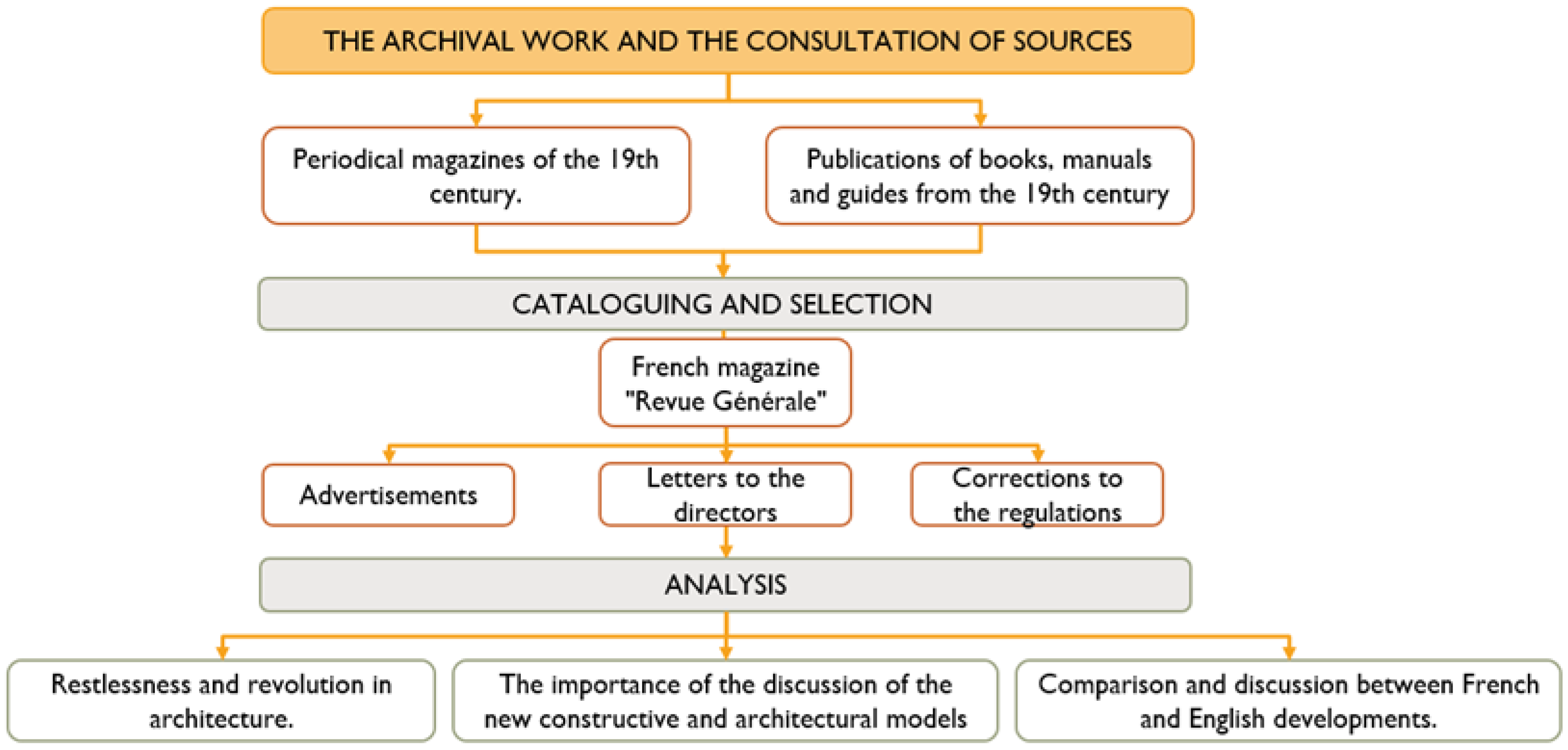
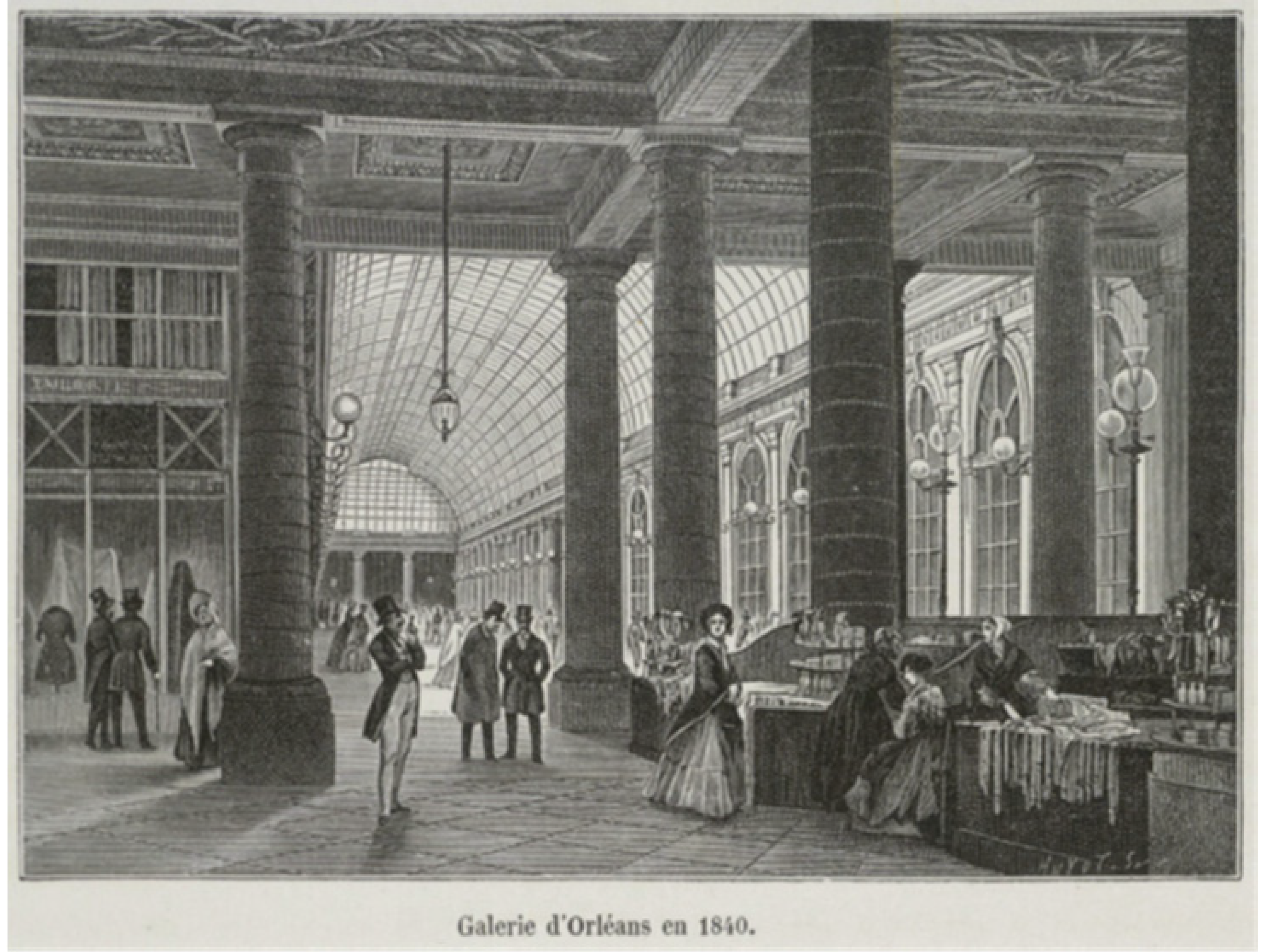
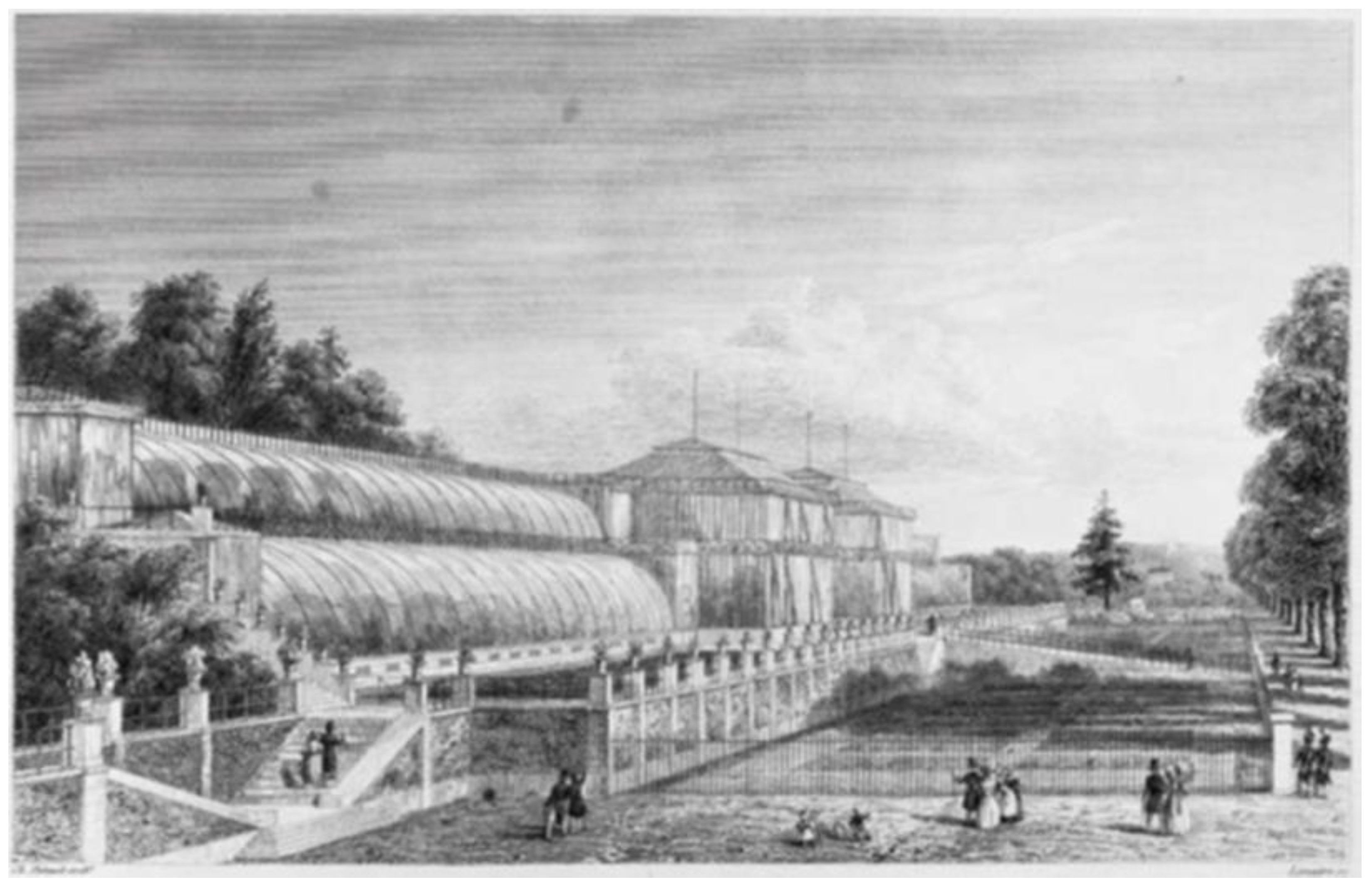
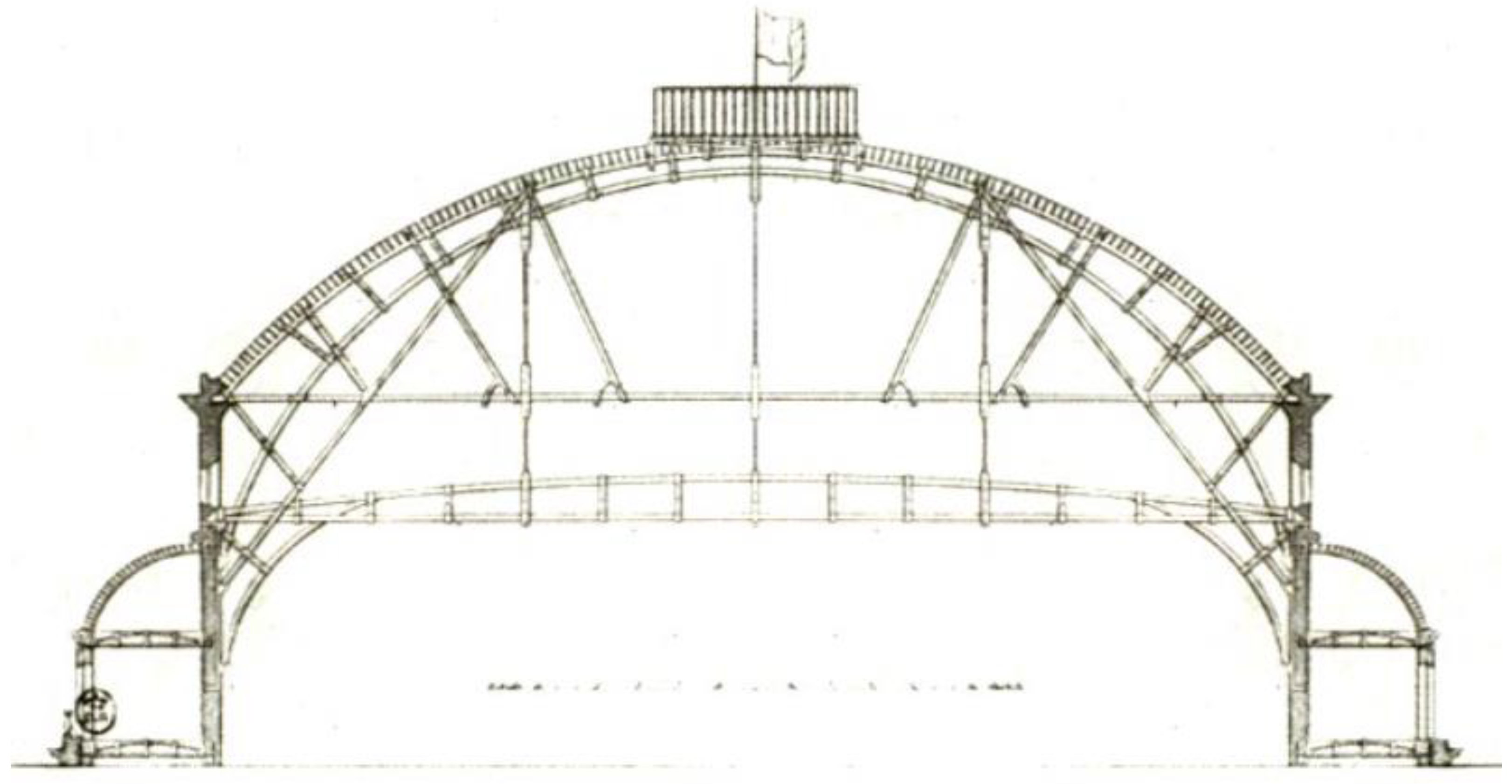
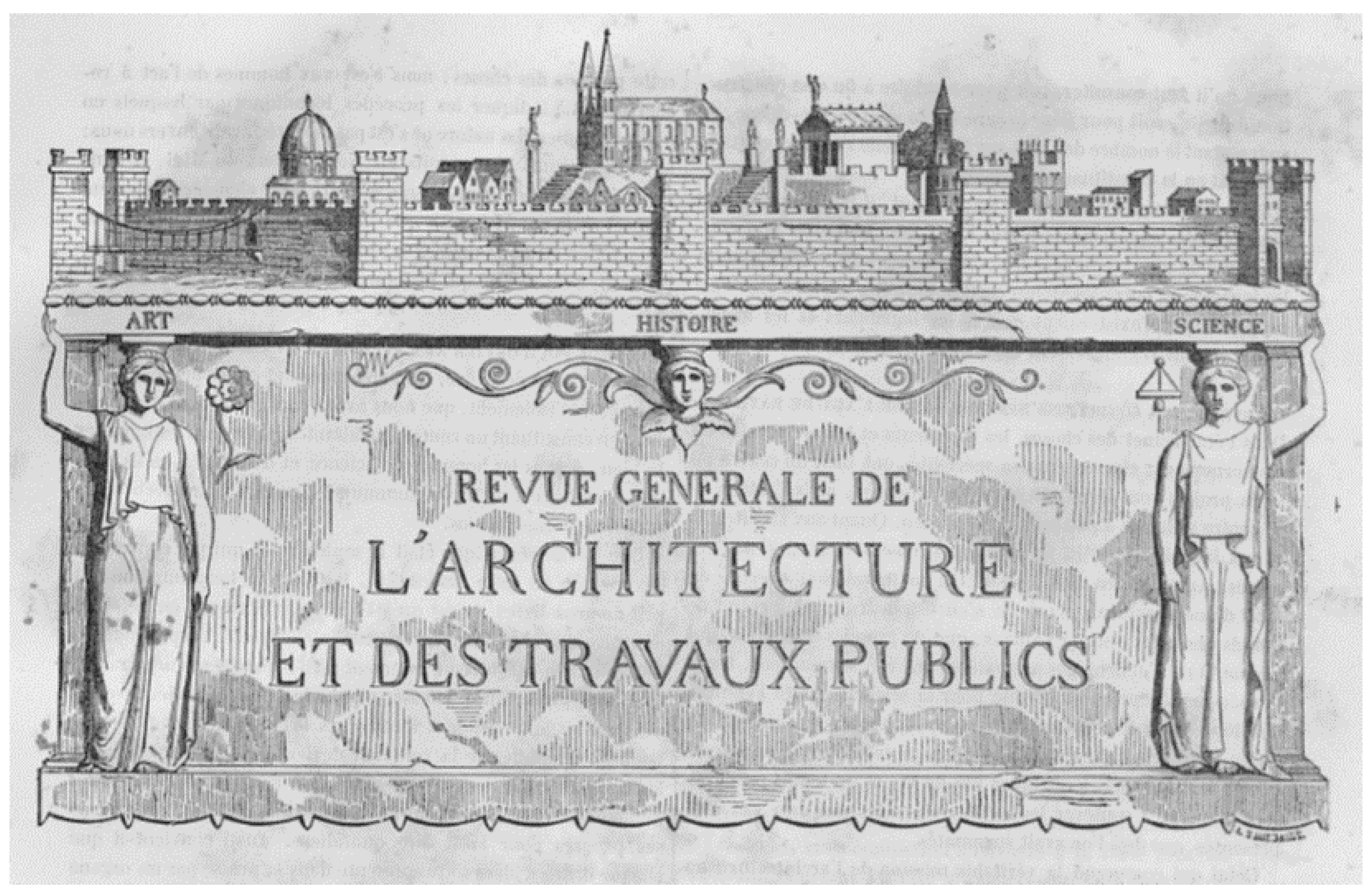
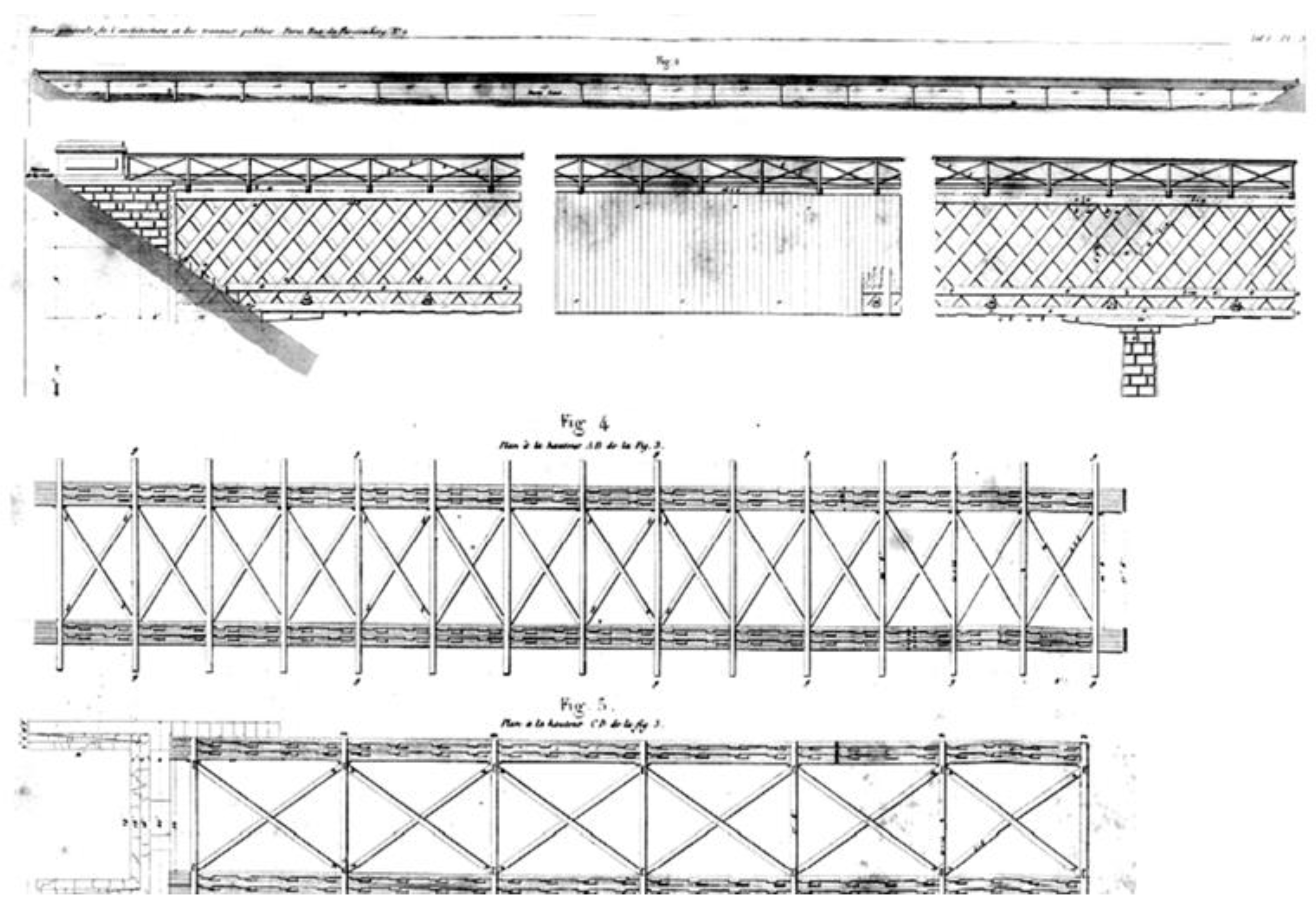
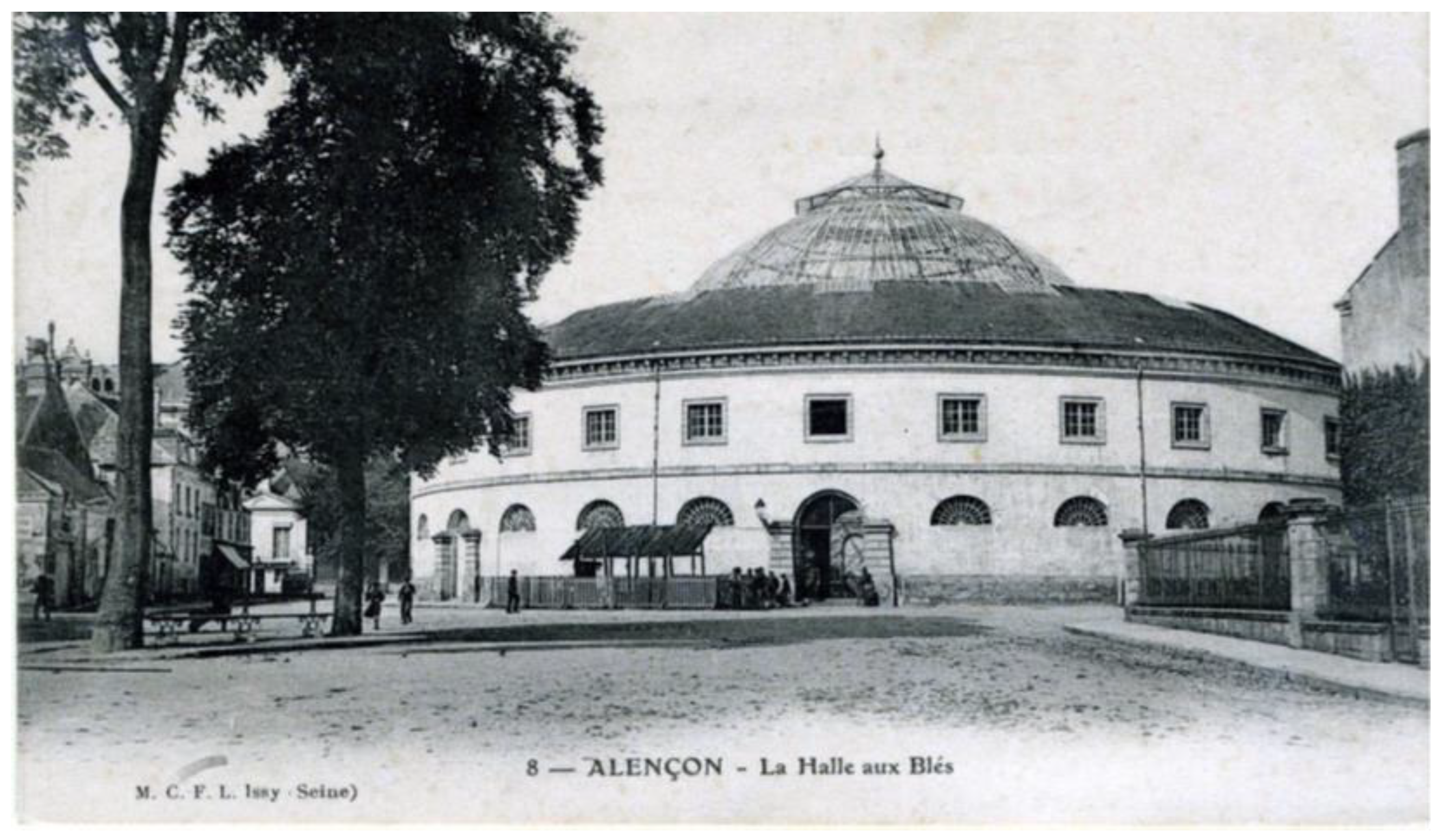
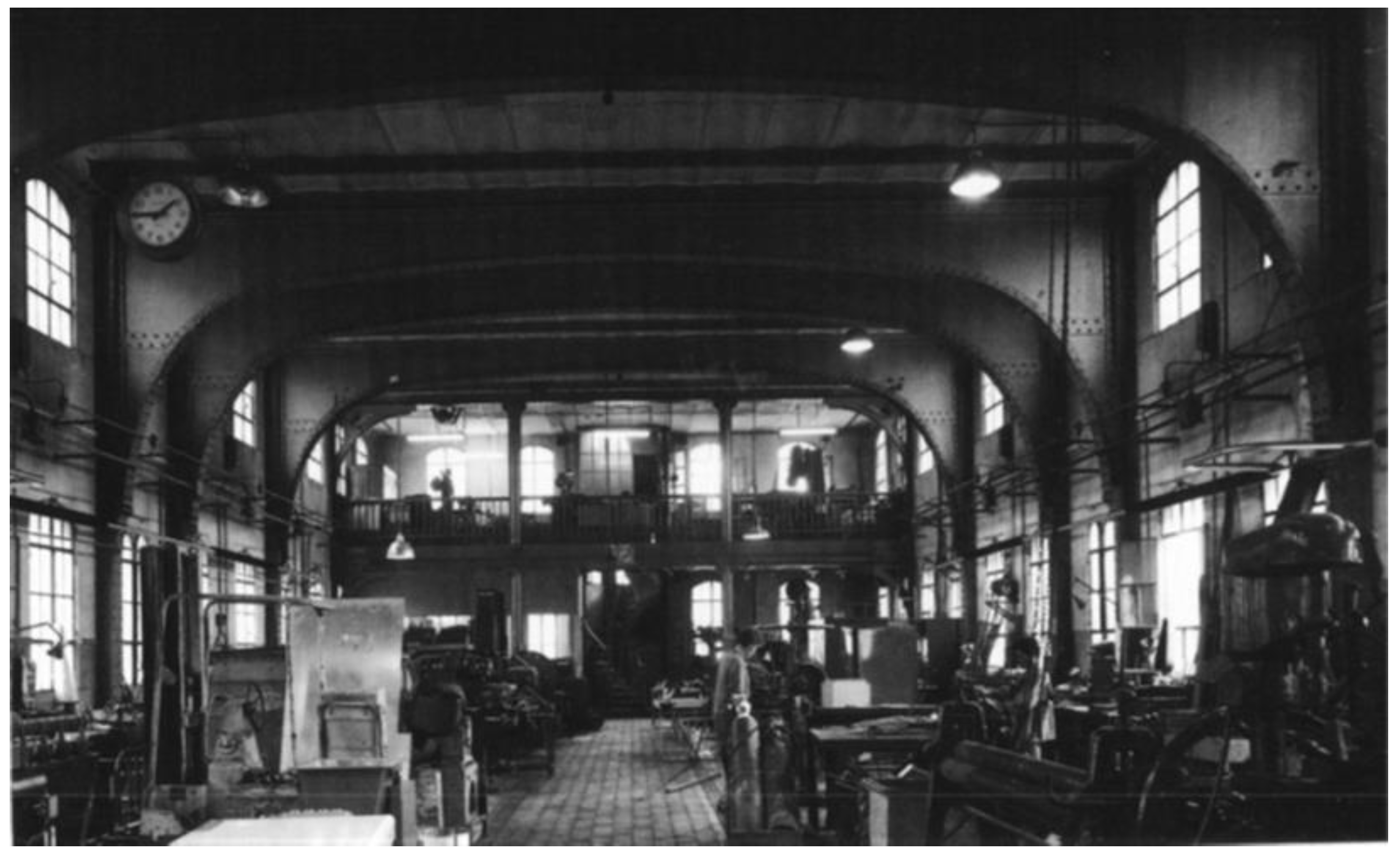
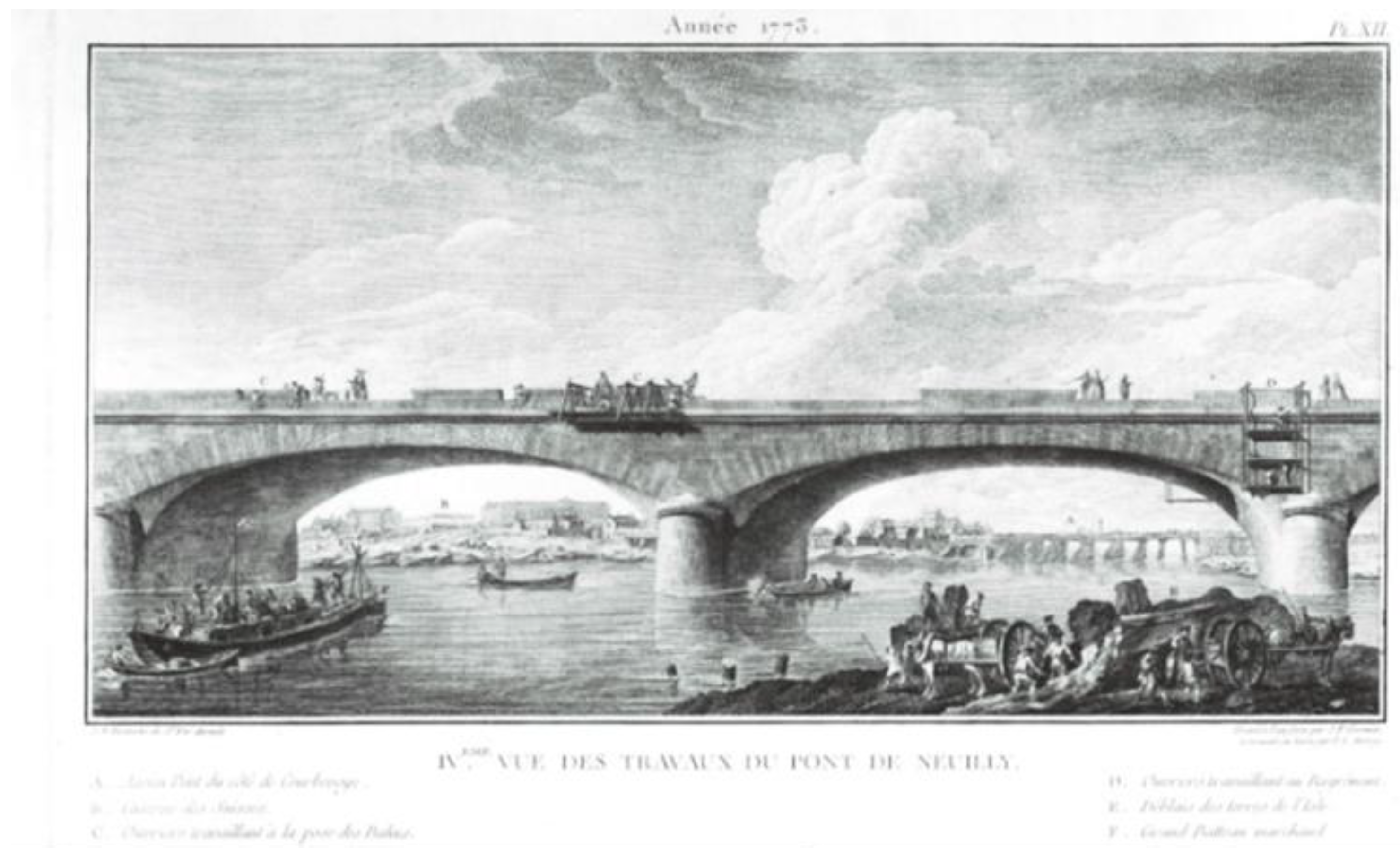
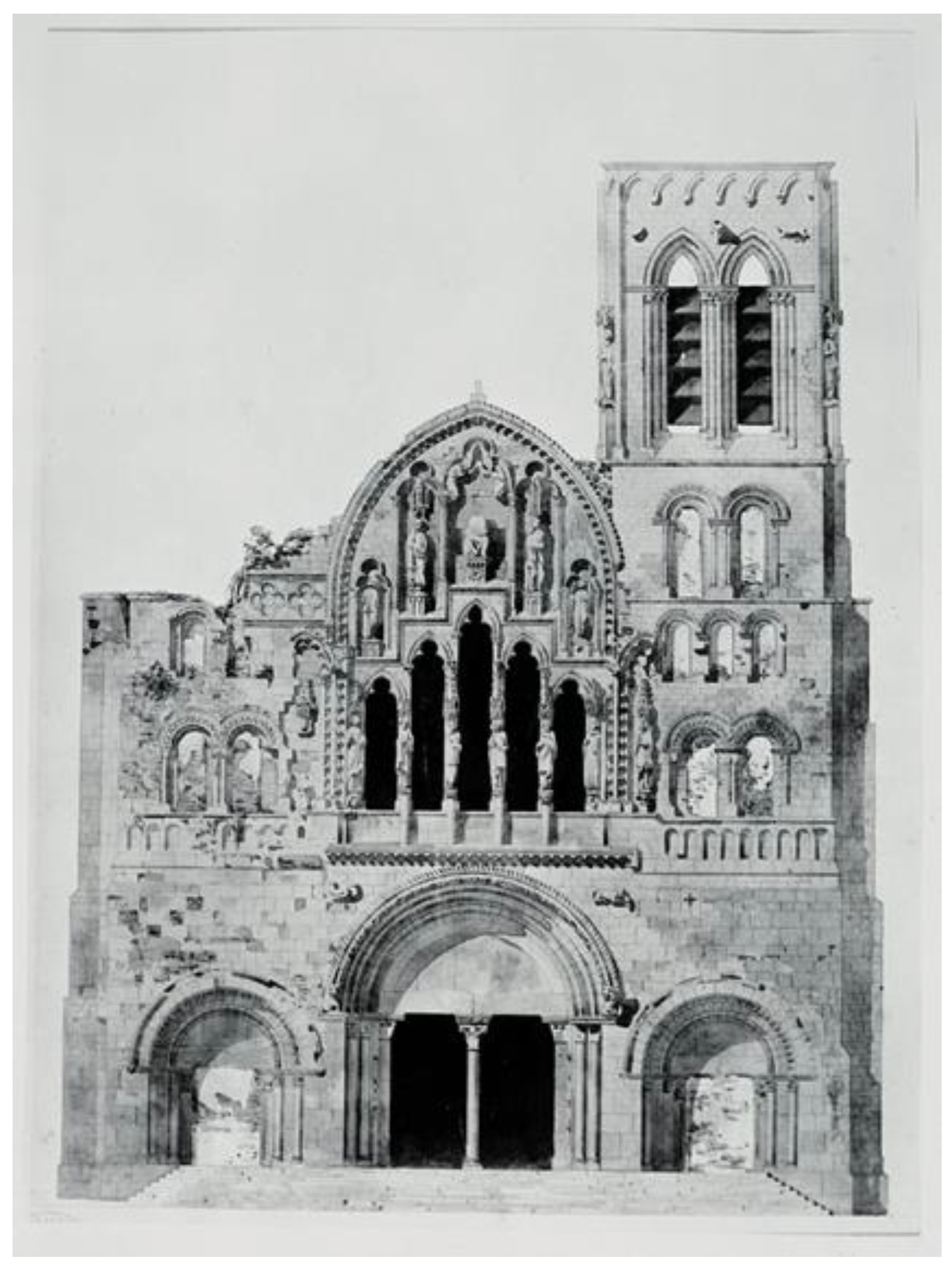

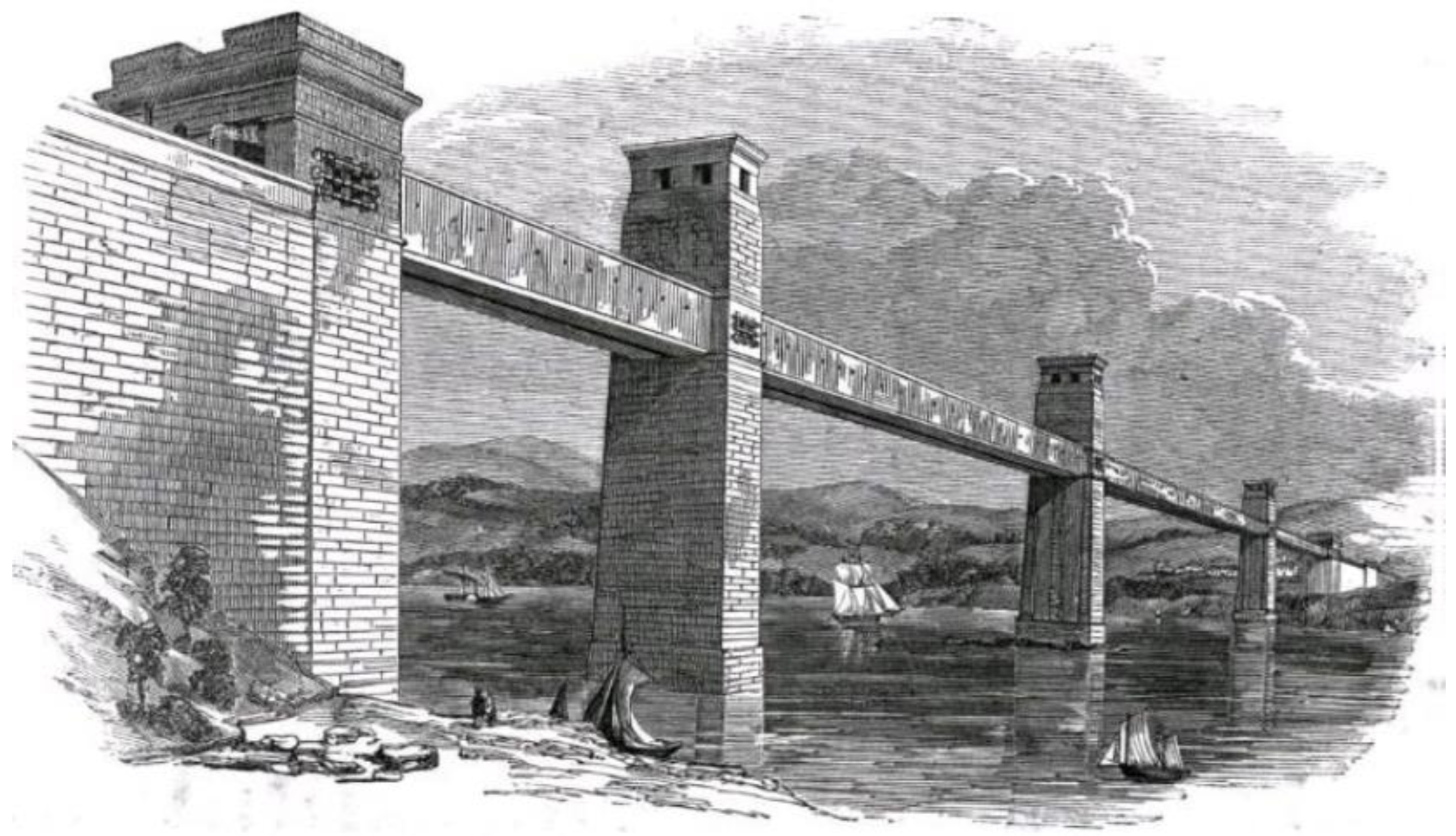
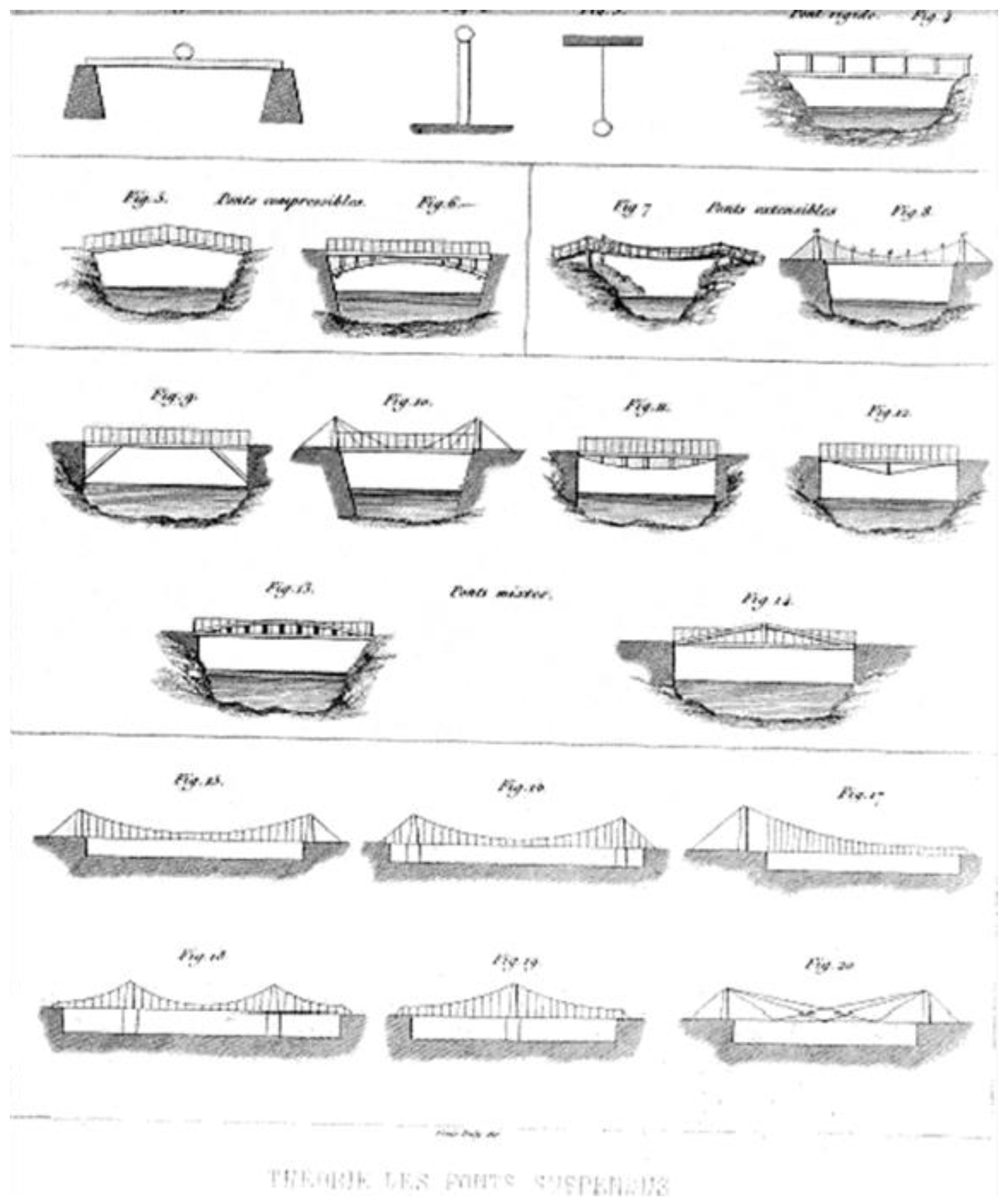
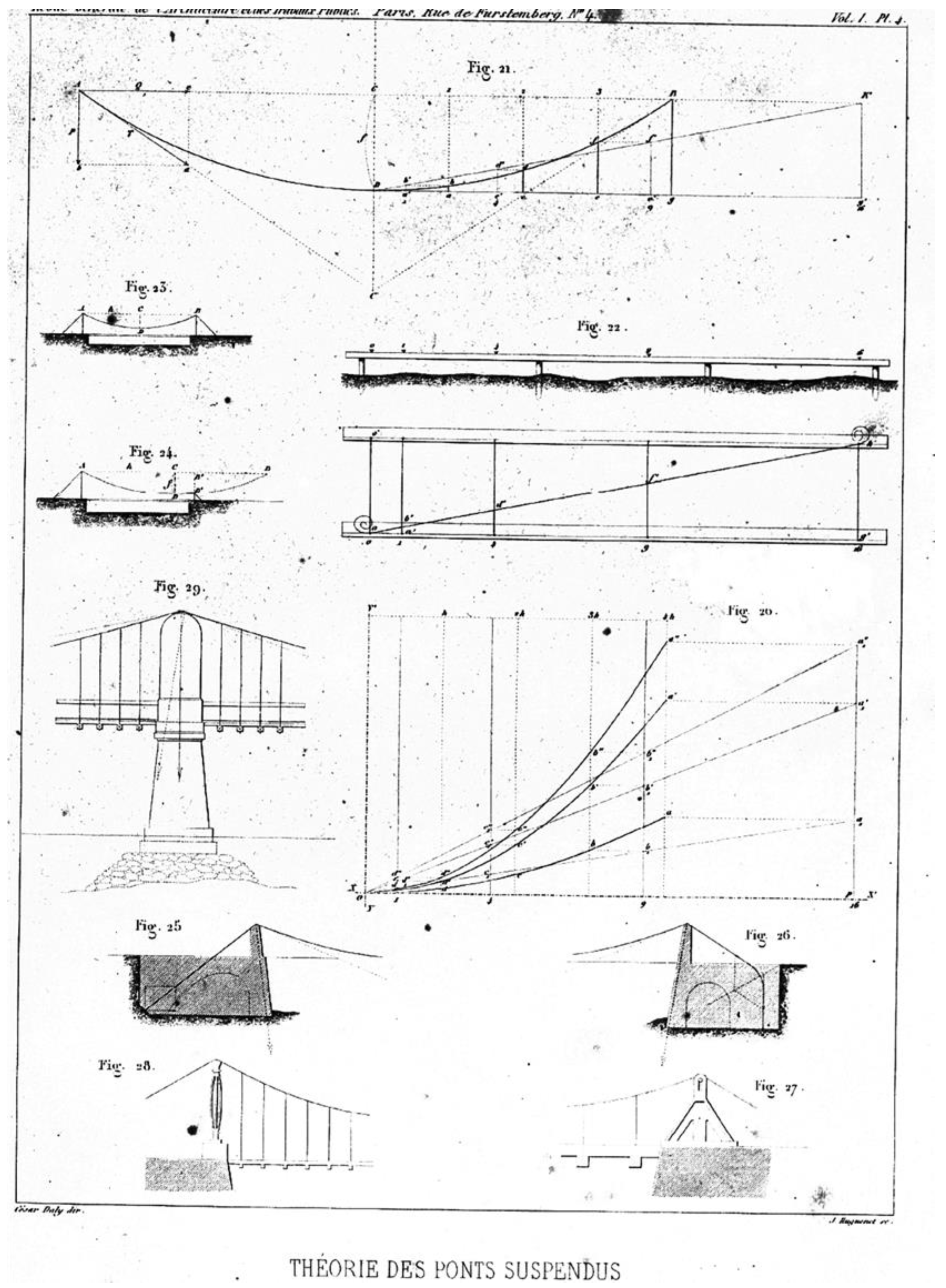
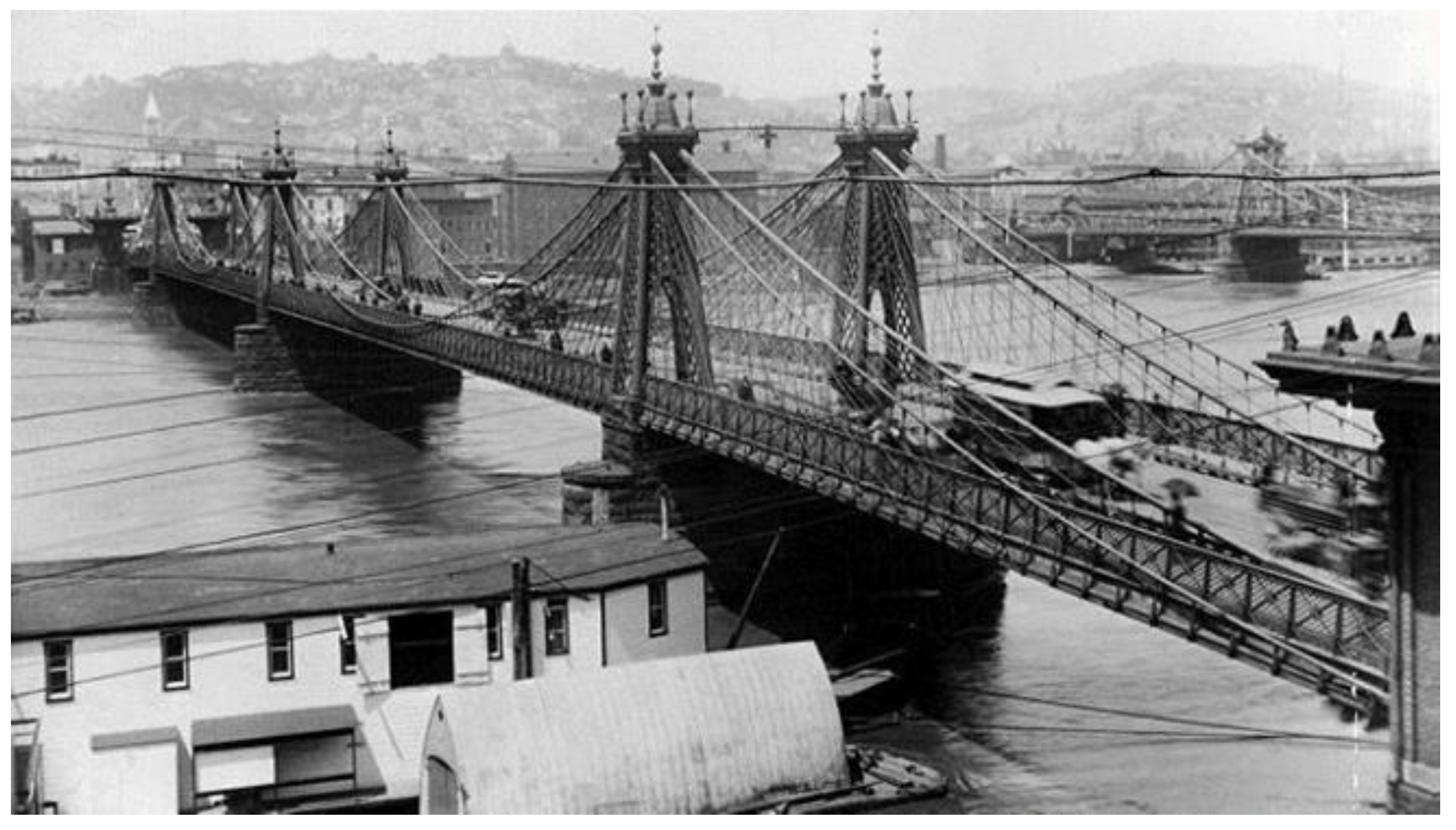
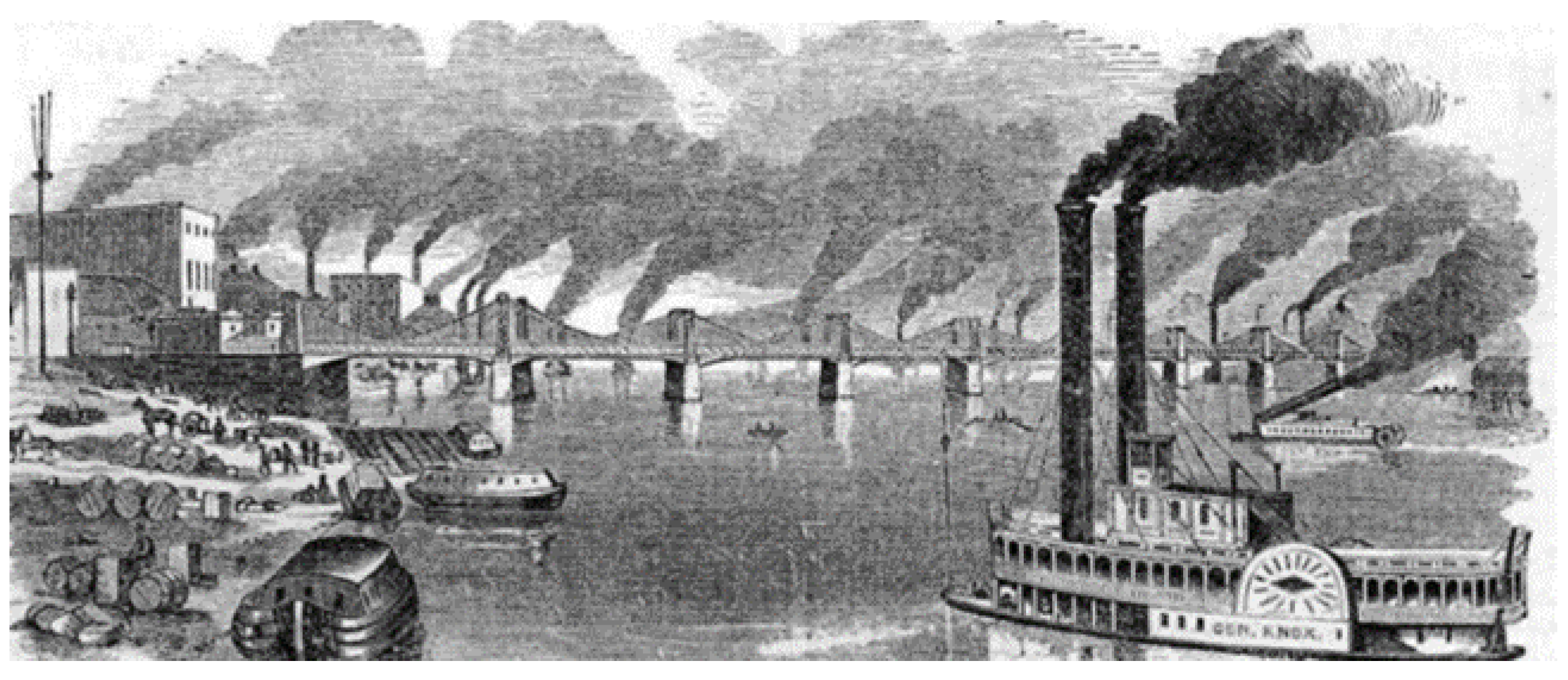
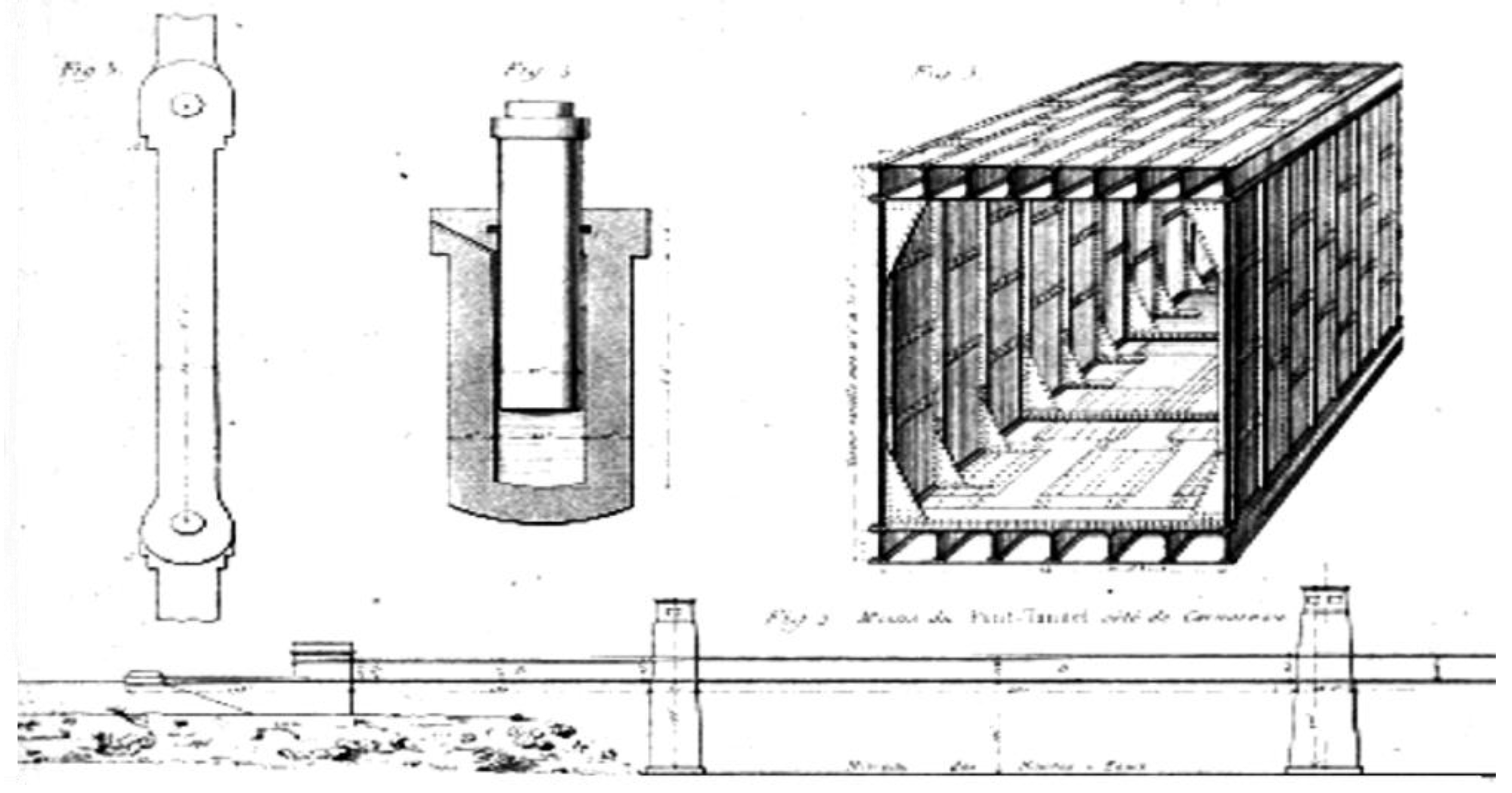

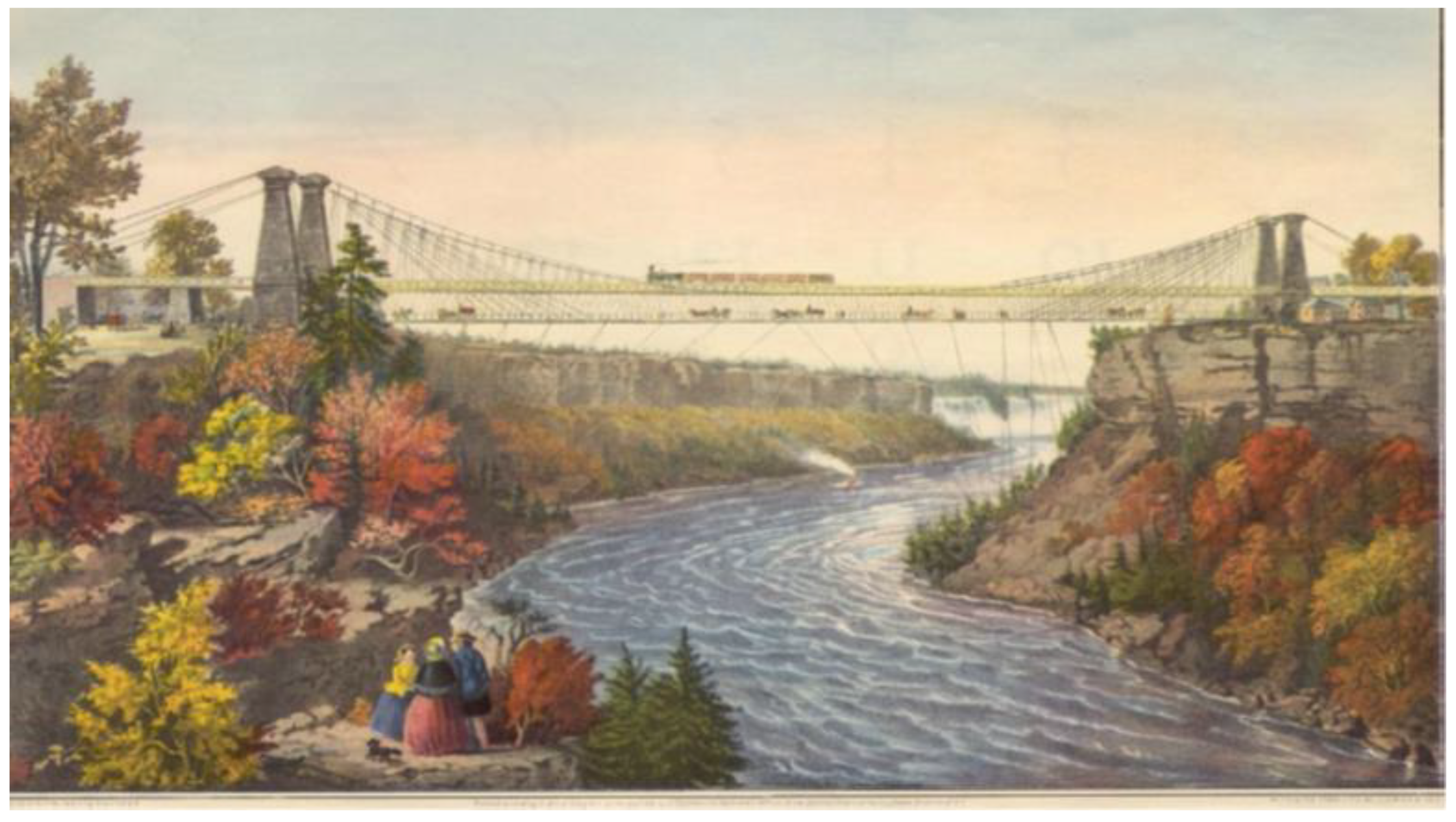
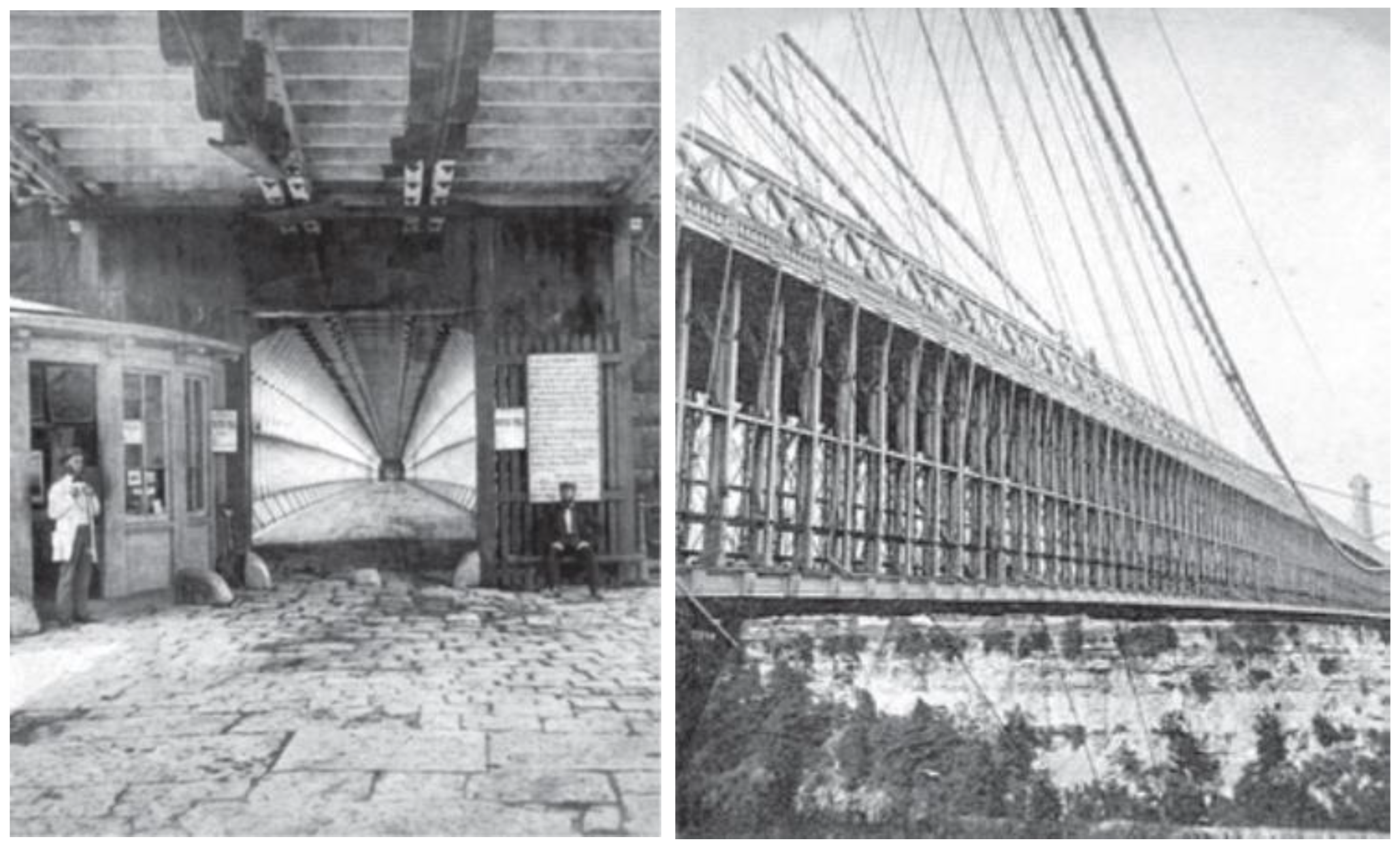
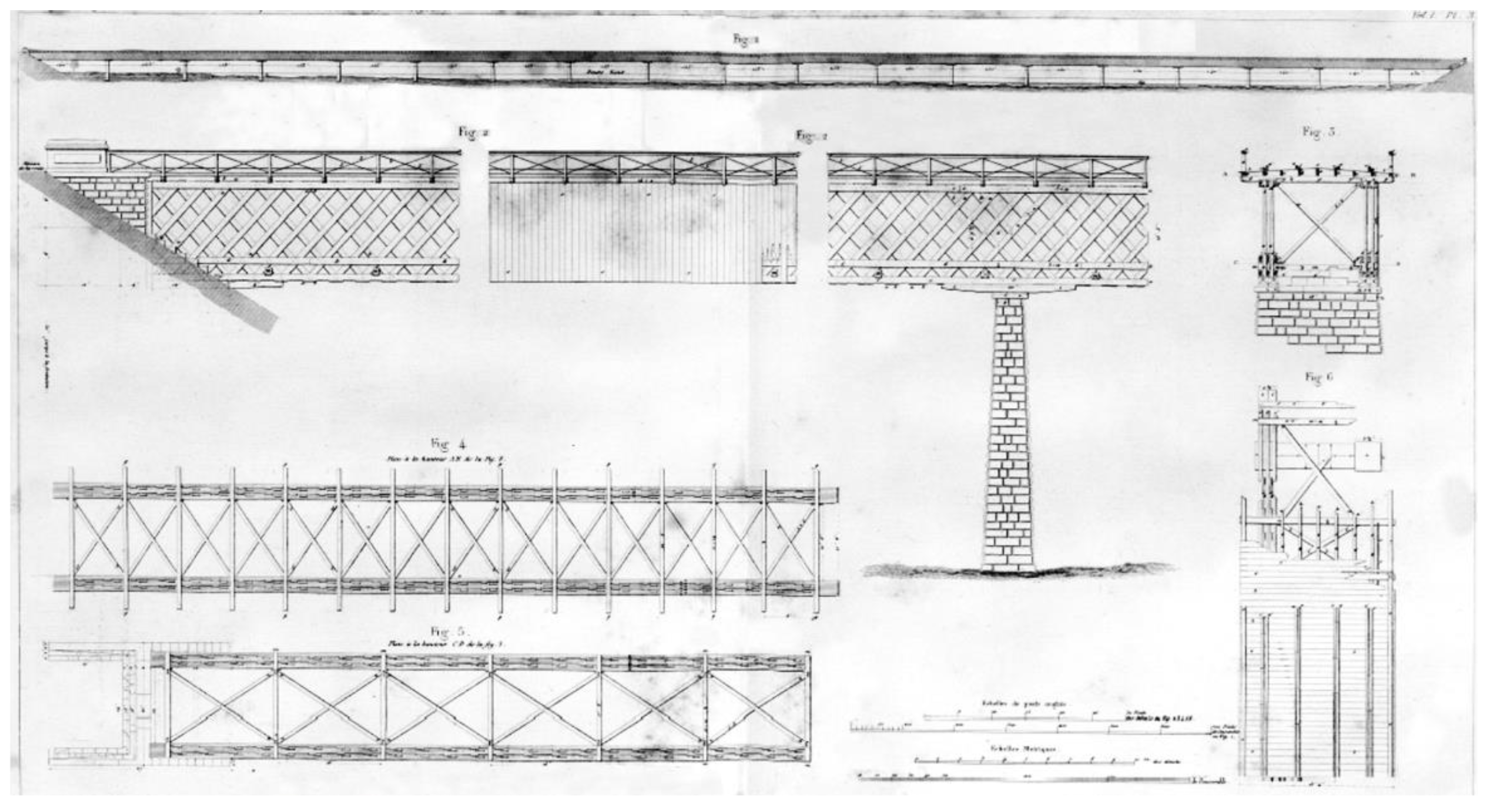
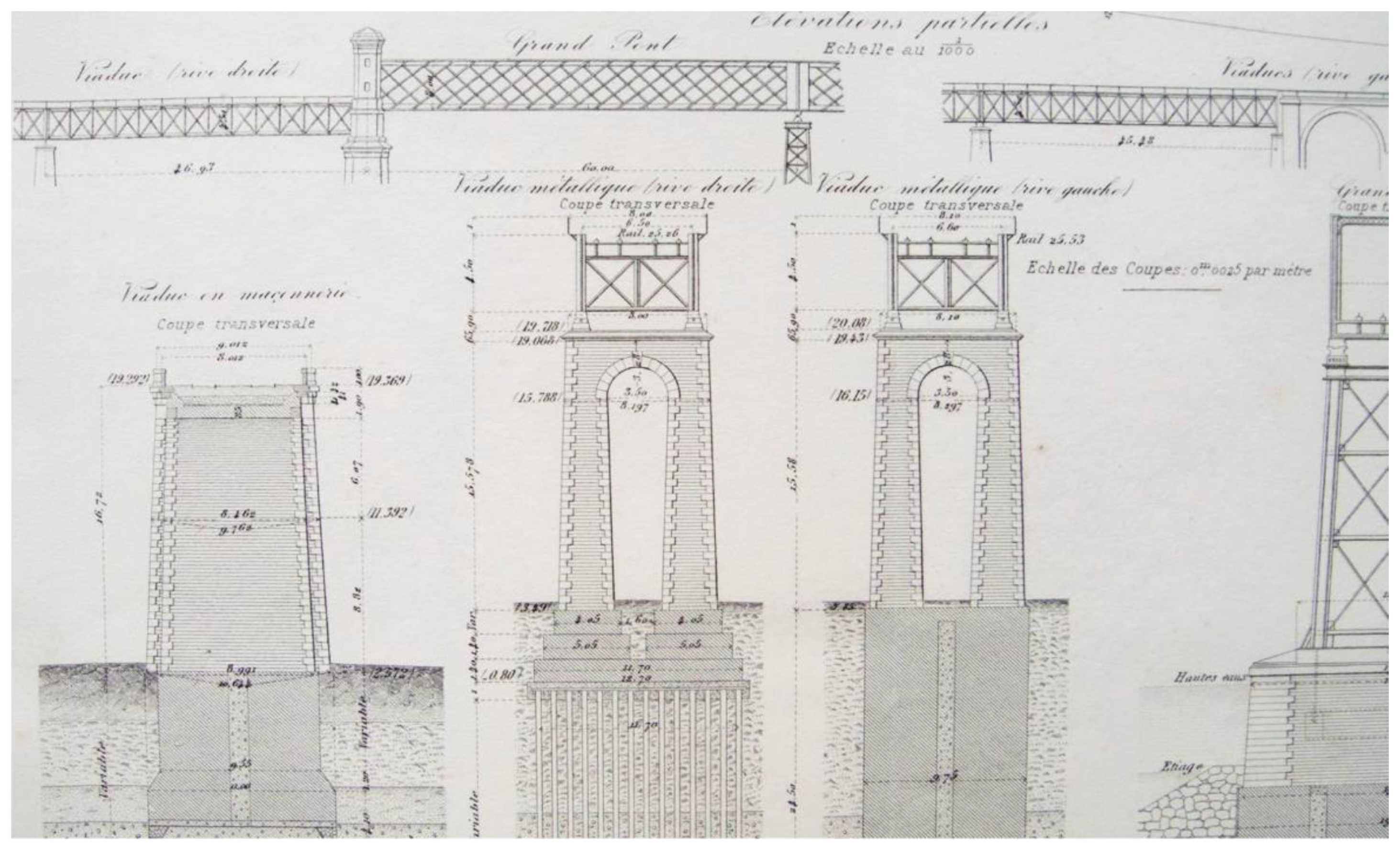
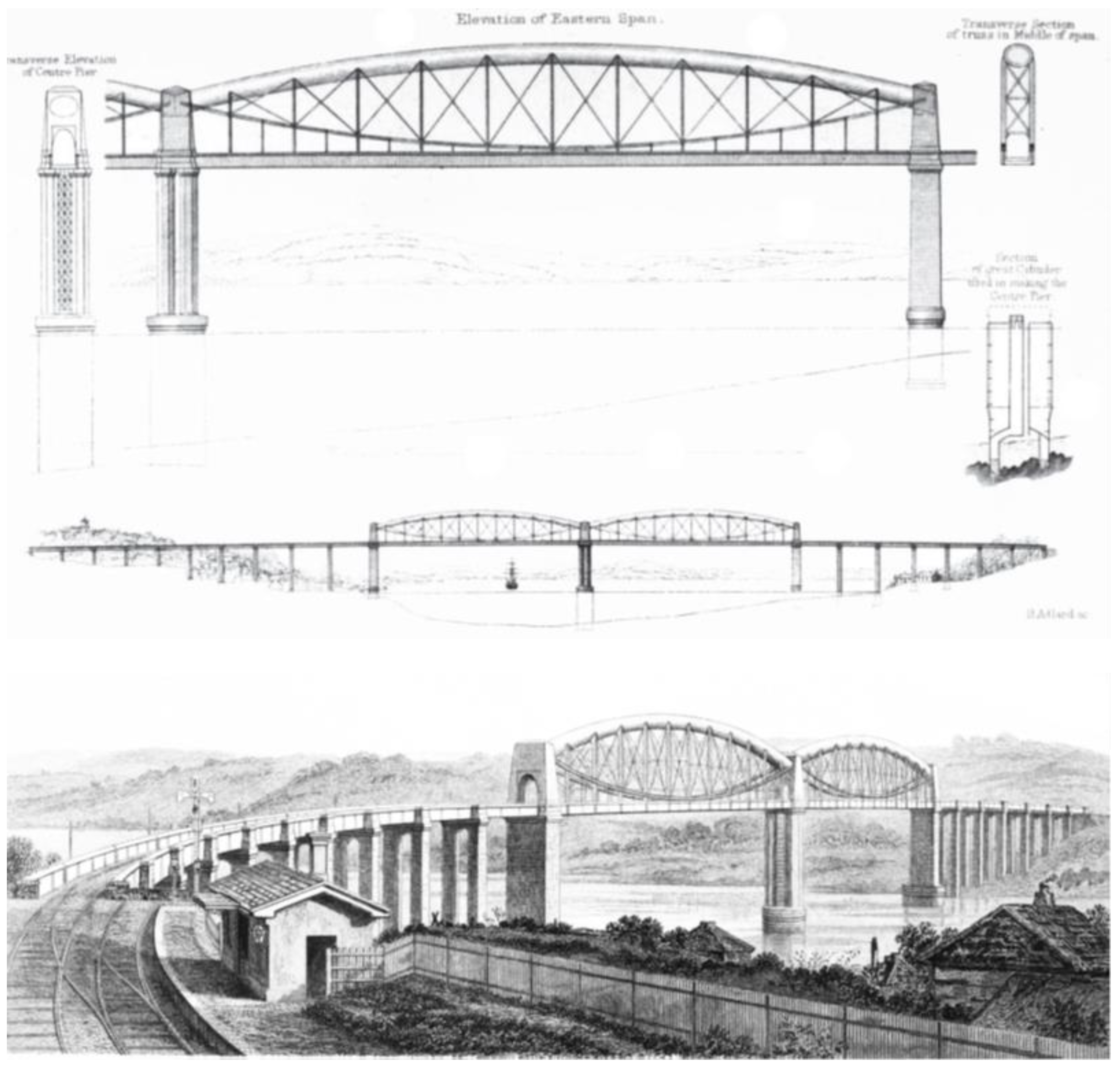



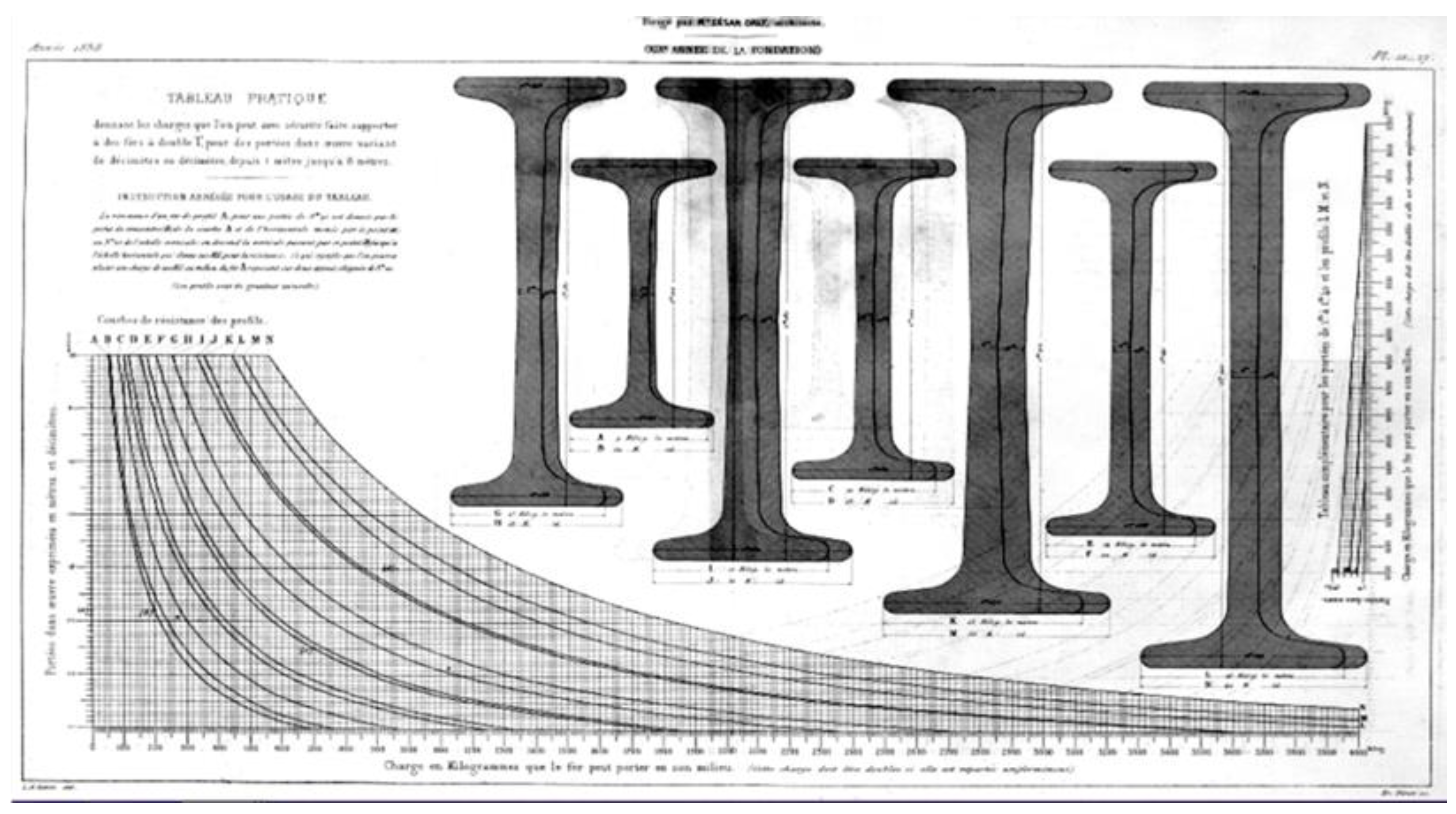
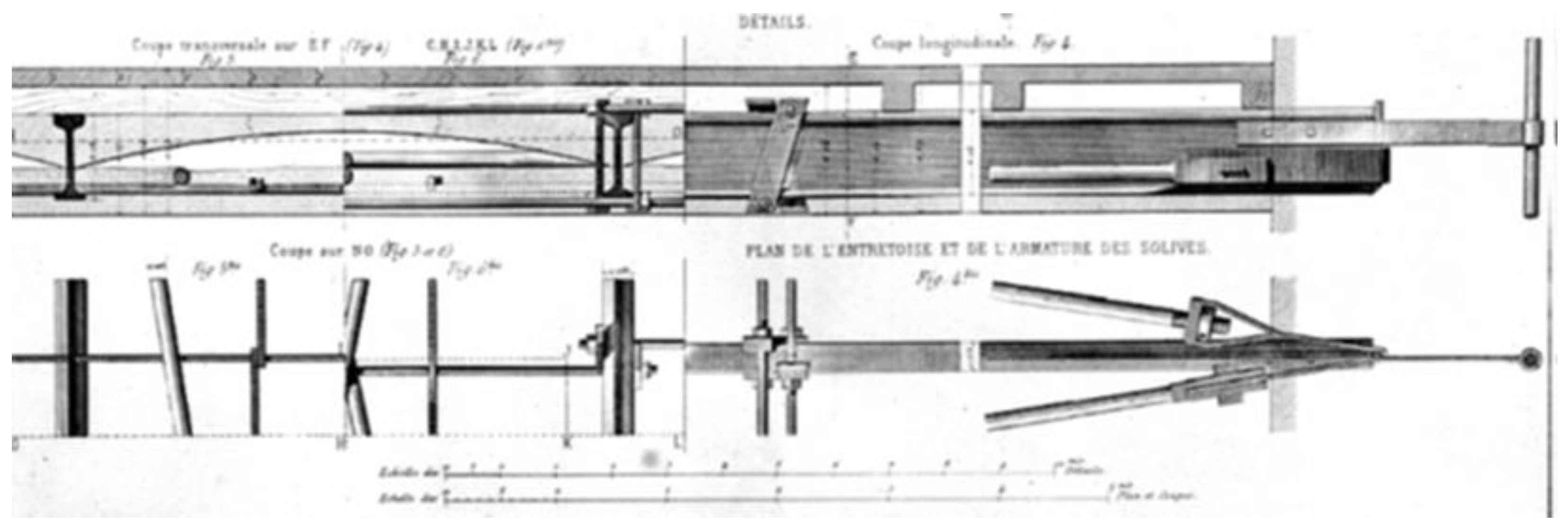
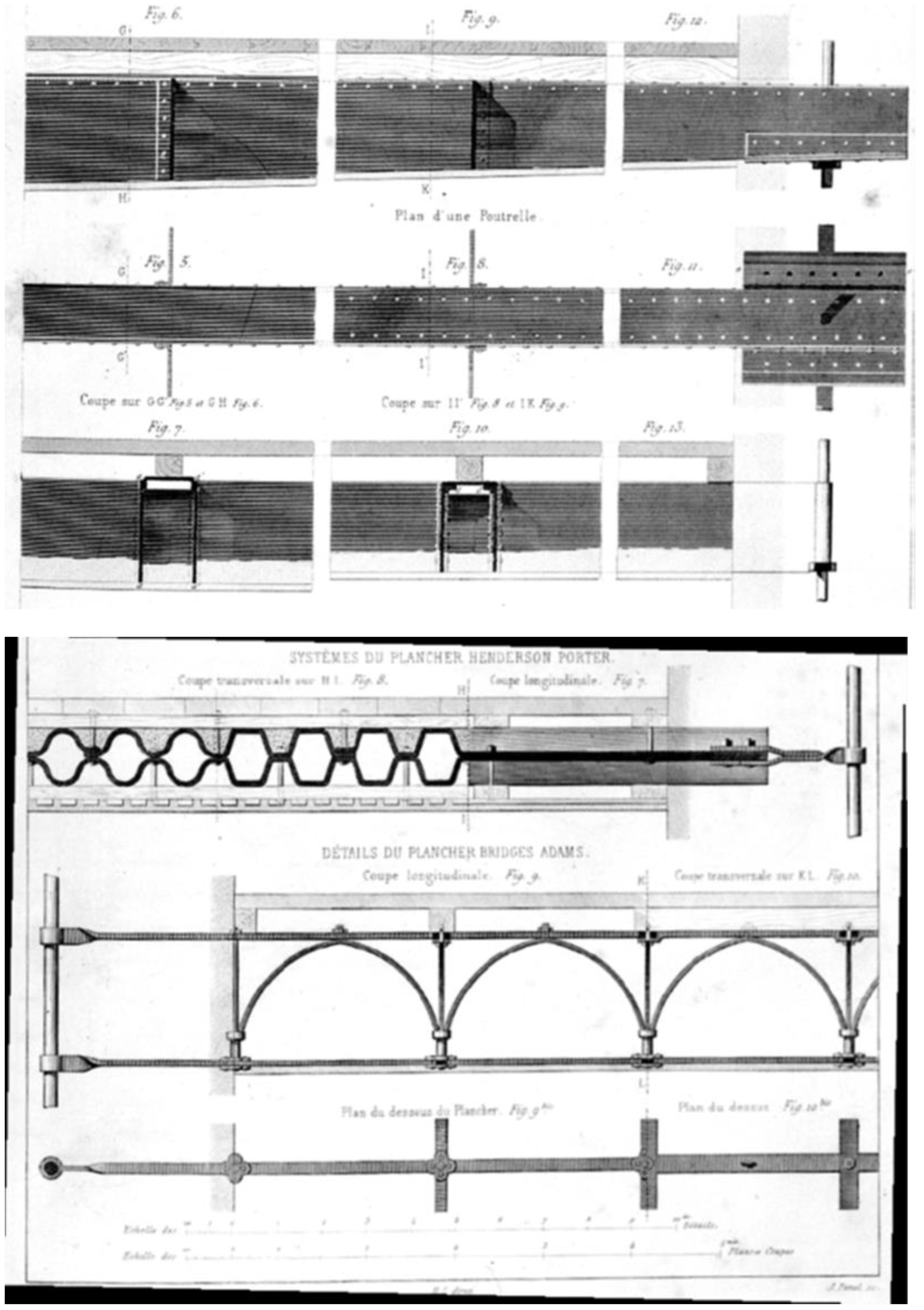
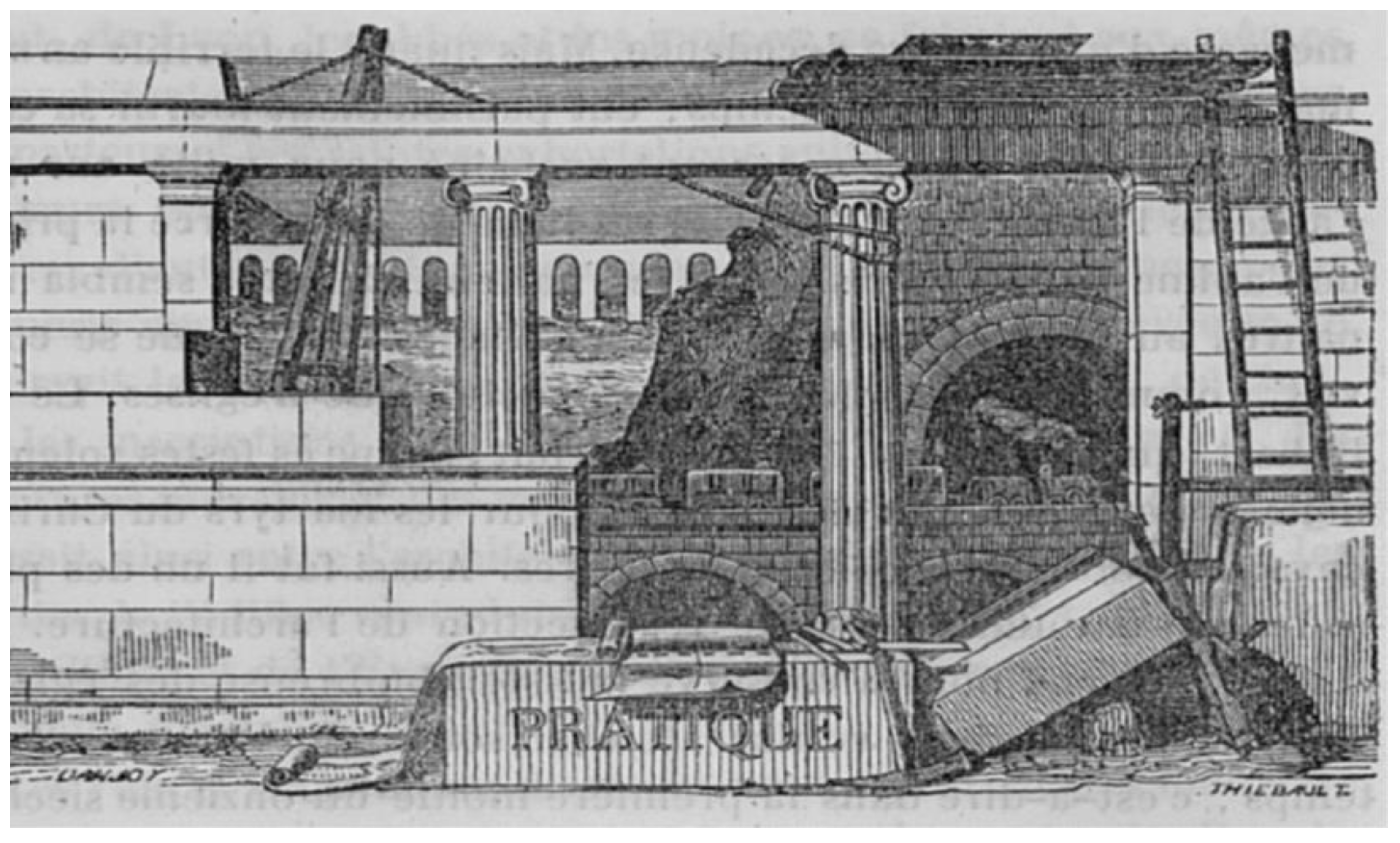
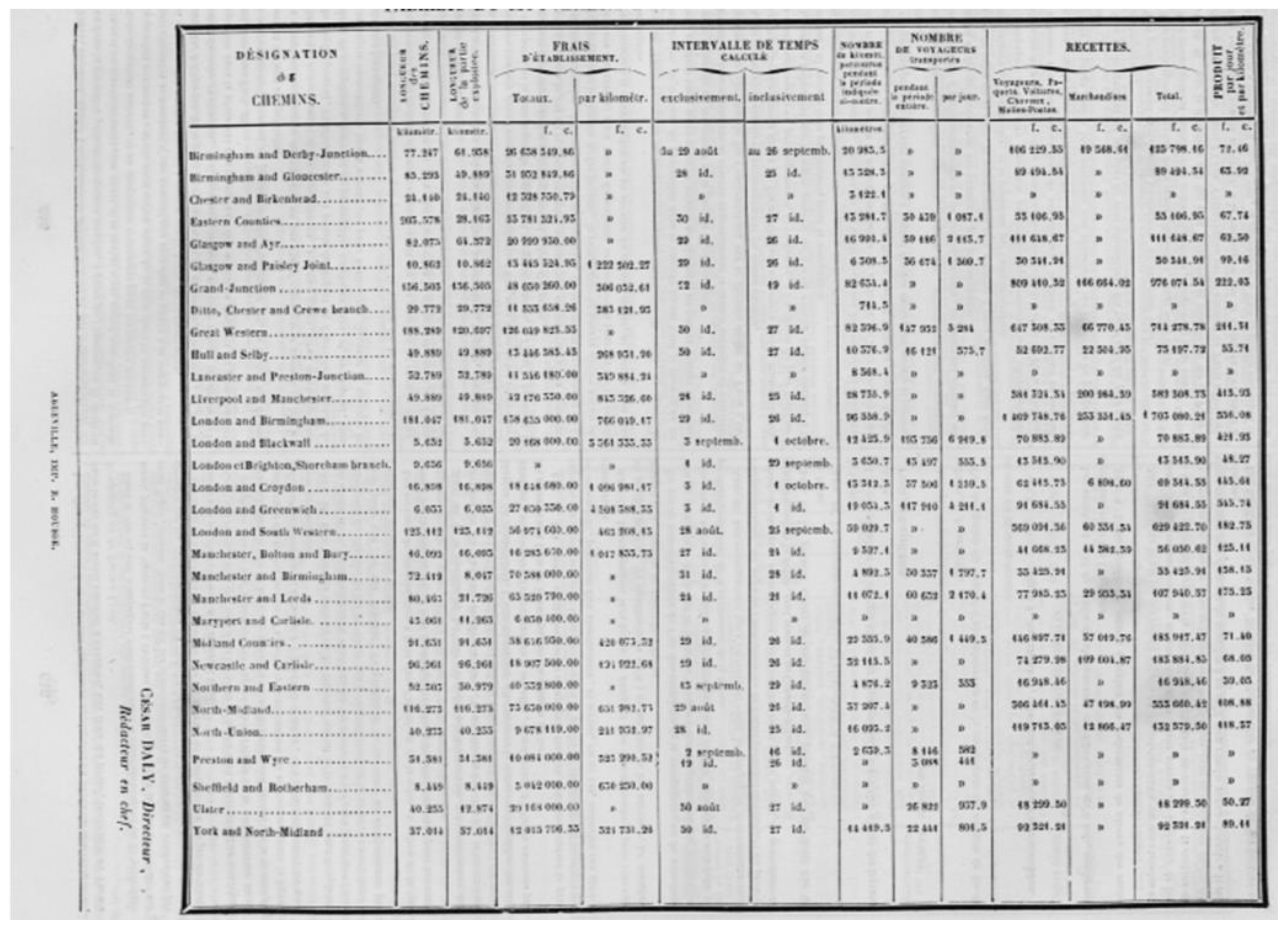
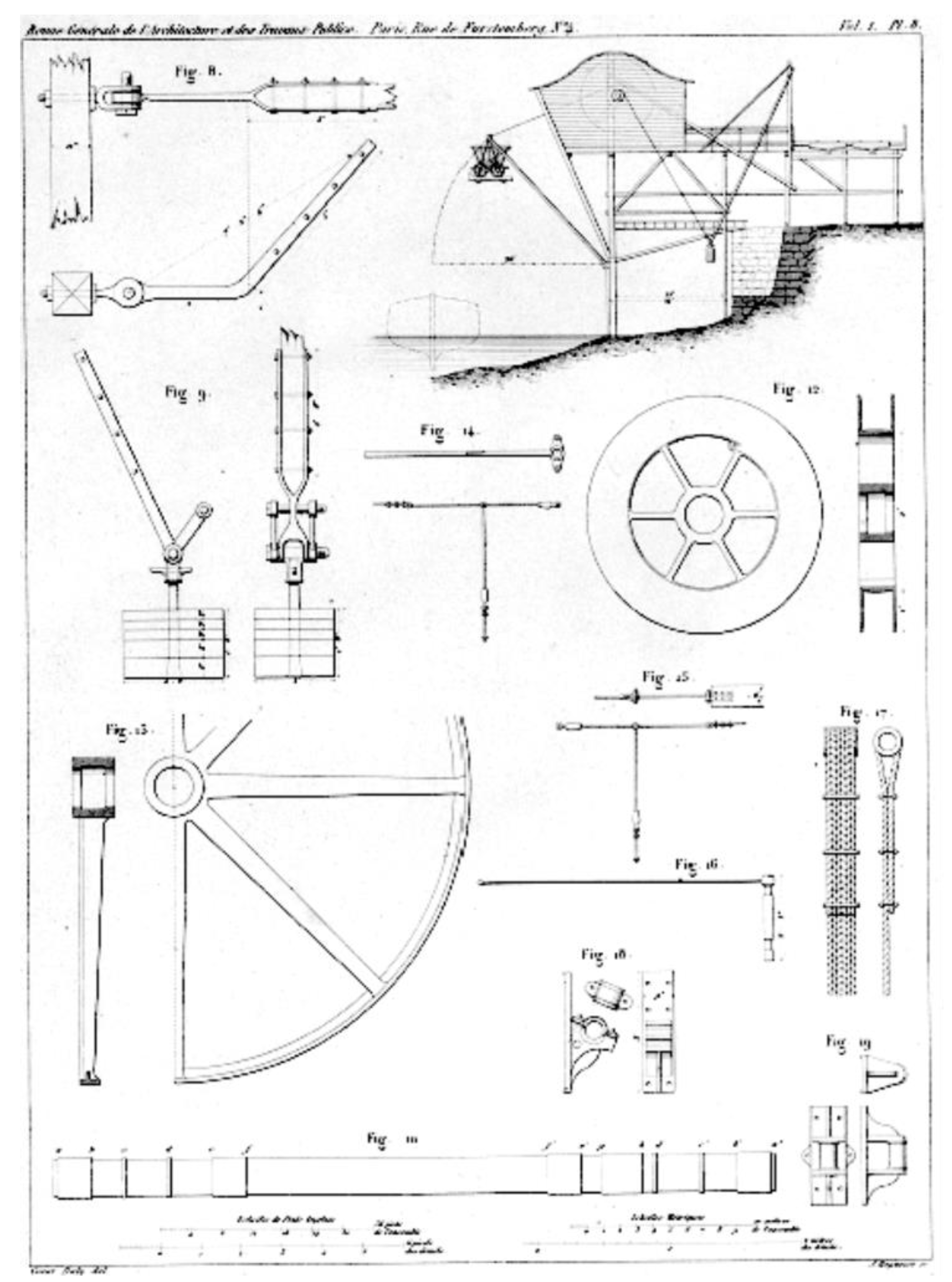
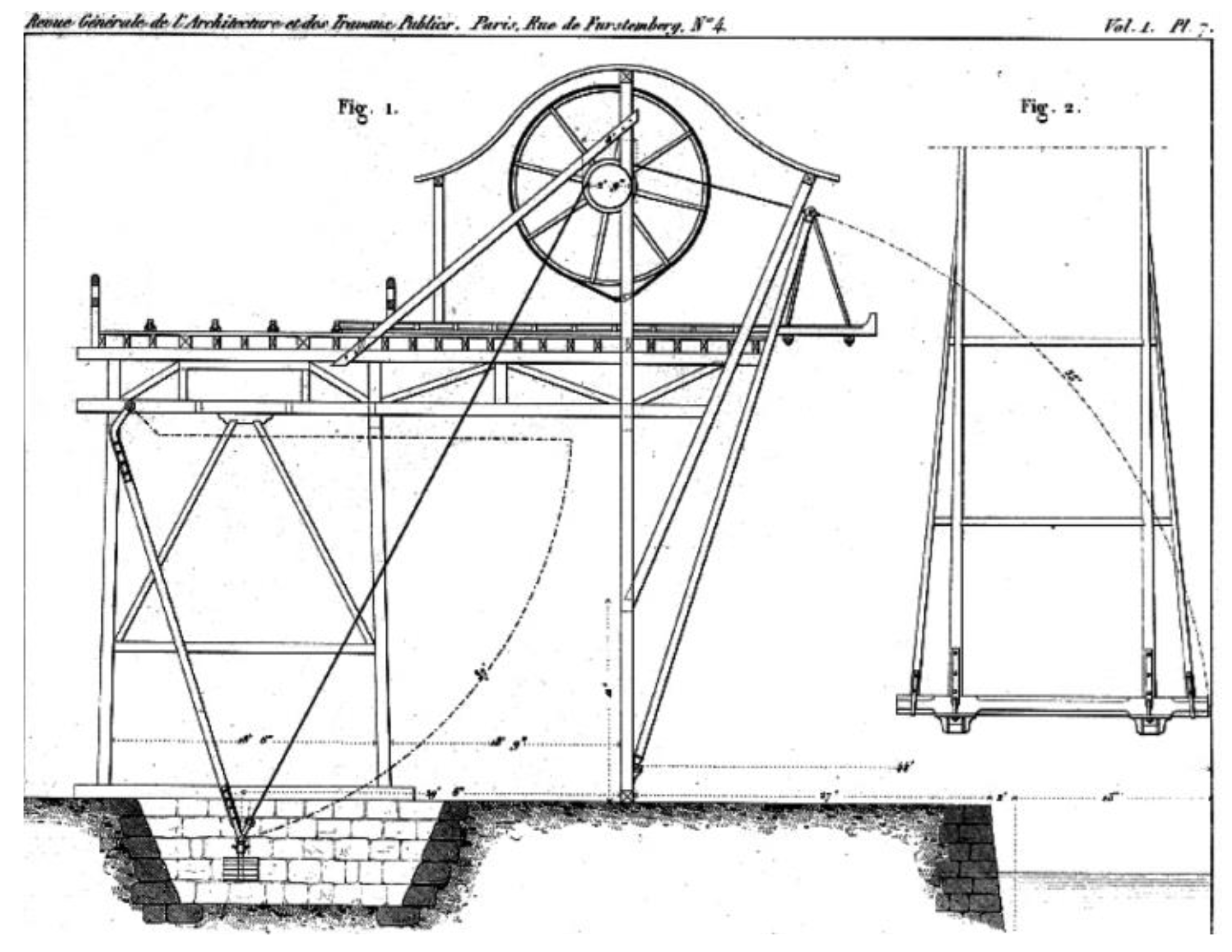
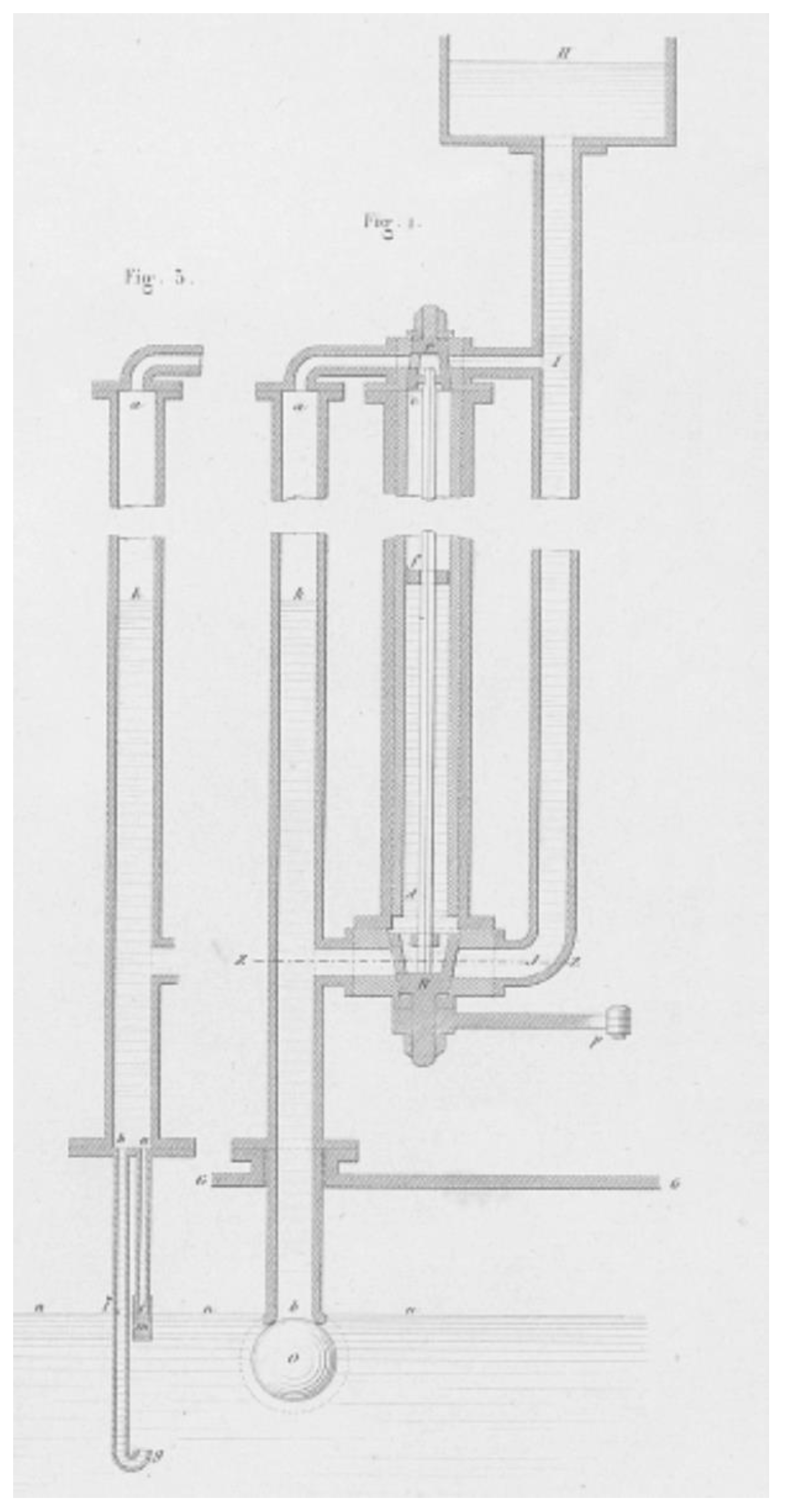
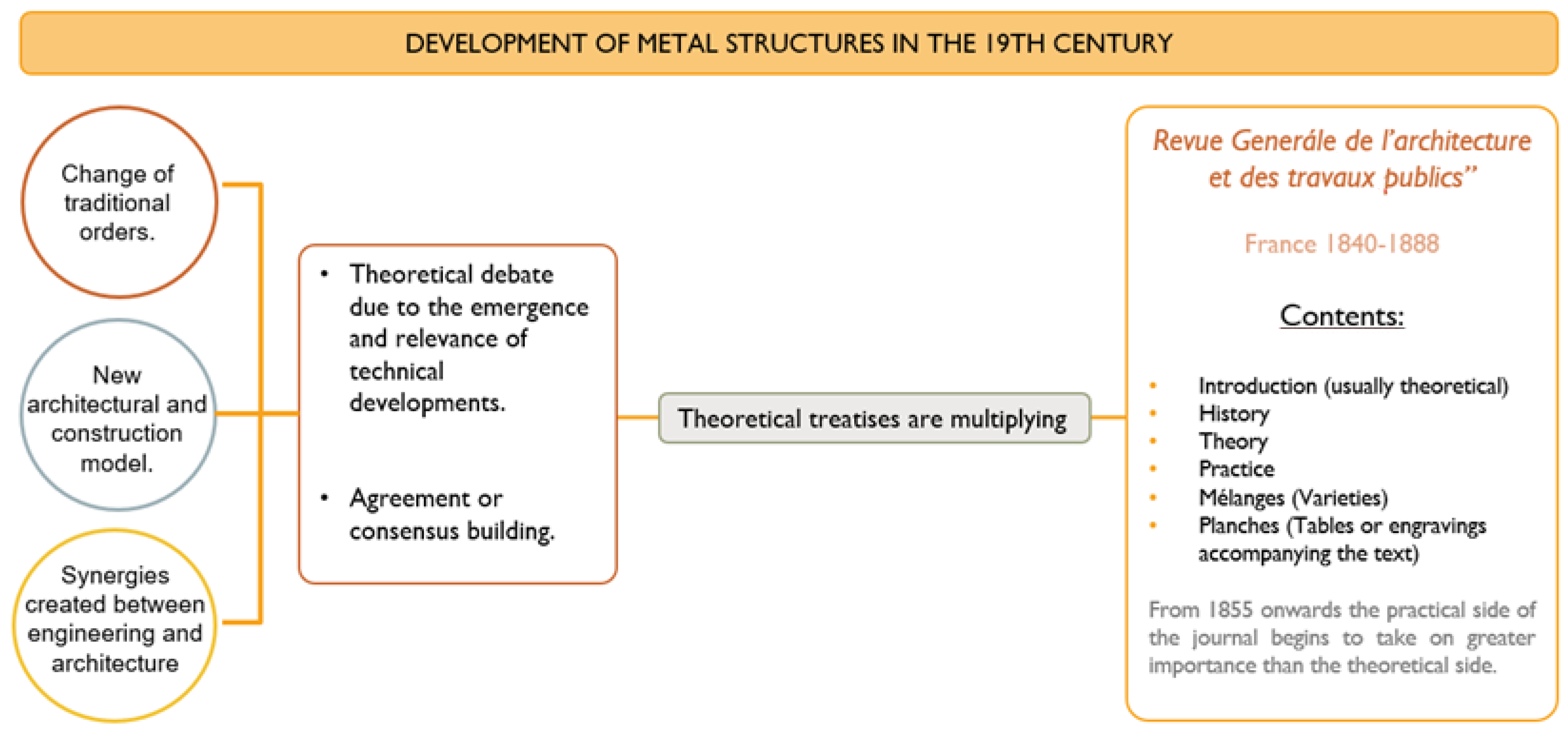
Disclaimer/Publisher’s Note: The statements, opinions and data contained in all publications are solely those of the individual author(s) and contributor(s) and not of MDPI and/or the editor(s). MDPI and/or the editor(s) disclaim responsibility for any injury to people or property resulting from any ideas, methods, instructions or products referred to in the content. |
© 2022 by the authors. Licensee MDPI, Basel, Switzerland. This article is an open access article distributed under the terms and conditions of the Creative Commons Attribution (CC BY) license (https://creativecommons.org/licenses/by/4.0/).
Share and Cite
Rueda Márquez de la Plata, A.; Cruz Franco, P.A. Analysis of the First Metallic Works That Represented a Geometric Innovation in Their Architectural Application: The Origin of the Architecture-Engineering Dichotomy. Metals 2023, 13, 32. https://doi.org/10.3390/met13010032
Rueda Márquez de la Plata A, Cruz Franco PA. Analysis of the First Metallic Works That Represented a Geometric Innovation in Their Architectural Application: The Origin of the Architecture-Engineering Dichotomy. Metals. 2023; 13(1):32. https://doi.org/10.3390/met13010032
Chicago/Turabian StyleRueda Márquez de la Plata, Adela, and Pablo Alejandro Cruz Franco. 2023. "Analysis of the First Metallic Works That Represented a Geometric Innovation in Their Architectural Application: The Origin of the Architecture-Engineering Dichotomy" Metals 13, no. 1: 32. https://doi.org/10.3390/met13010032
APA StyleRueda Márquez de la Plata, A., & Cruz Franco, P. A. (2023). Analysis of the First Metallic Works That Represented a Geometric Innovation in Their Architectural Application: The Origin of the Architecture-Engineering Dichotomy. Metals, 13(1), 32. https://doi.org/10.3390/met13010032





